Categories
- Argentina
- Chile
- Antarctica
- Easter Island
- Falklands (Malvinas)
- Bolivia
- Peru
- Uruguay
- Paraguay
- Brazil
- Venezuela
- Colombia
- Ecuador
- Galapagos
- Panama
- Costa Rica
- Cuba
- Nicaragua
- Honduras
- El Salvador
- Guatemala
- Belize
- Mexico
- Latin American Xmas
Pages
- Street Art of Buenos Aires
- A week in Buenos Aires
- The Jesuit Missions in South America
- Contact Us
- Map of Central America
- First week in Latin America – October 2009
- Home Page
- Map of South America
Archives
- October 2011 (3)
- September 2011 (9)
- August 2011 (10)
- July 2011 (7)
- June 2011 (6)
- May 2011 (11)
- April 2011 (10)
- March 2011 (4)
- February 2011 (5)
- January 2011 (6)
- December 2010 (6)
- November 2010 (4)
- October 2010 (8)
- September 2010 (5)
- August 2010 (7)
- July 2010 (5)
- June 2010 (6)
- May 2010 (6)
- April 2010 (7)
- March 2010 (6)
- February 2010 (9)
- January 2010 (4)
- December 2009 (8)
- November 2009 (5)
- October 2009 (2)
Mérida
29th June 2011
In the quaint colonial town of Izamal [7], one of México´s Pueblos Mágicos, all the central buildings are painted in egg yolk yellow. Towering above everything else is the Franciscan church and convent, built on top and out of a Mayan pyramid. The Spanish monk Fray Diego de Landa who founded the Monastery later burnt all the Maya writings – lost forever (only 4 books remain). There are various Maya pyramids scattered about town, even the remains of one in our hotel´s garden.
.
When Francisco de Montejo and his Conquistadores arrived at the Maya city of T’ho in 1542, the white limestone covered buildings reminded them of the Roman city of Mérida [8] back in Spain. They renamed the oldest continually occupied city in the Americas and then proceeded to dismantle it, using the stone for the construction of churches and public buildings. We got there on a wet and windy day. Thoroughly soaked, we set out to explore the colonial architecture. The rain had eased the next day as we bussed and hour and a half out to Uxmal, one of the best restored Mayan sites with magnificent examples of Puuc construction – buildings beautifully decorated with carefully cut stones, often featuring the God of Rain, Chac.
.
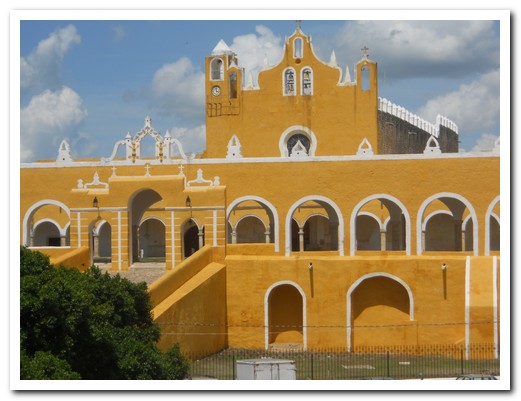
The view from our hotel balcony - the Monastery in Izamal, the largest in the Americas
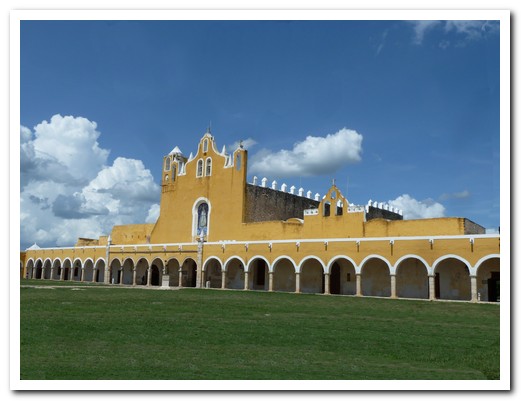
The largest courtyard outside of St Peters (Rome)
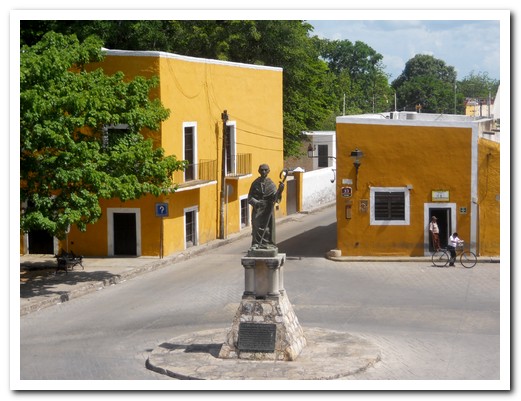
Fray Diego de Landa, builder of the Monastery, burner of the Mayan books, Bishop of Yucatán
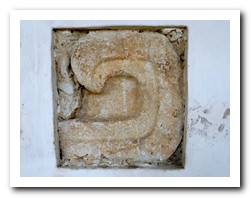 |
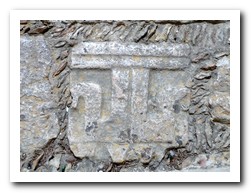 |
| Two of the stones taken from a Mayan temple used in the Monastery |
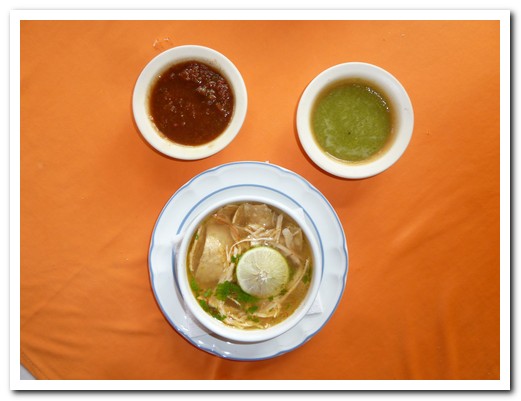
Sopa de Lima - broth of limes, shredded turkey & tortillas (add tomato or chilli sauce)
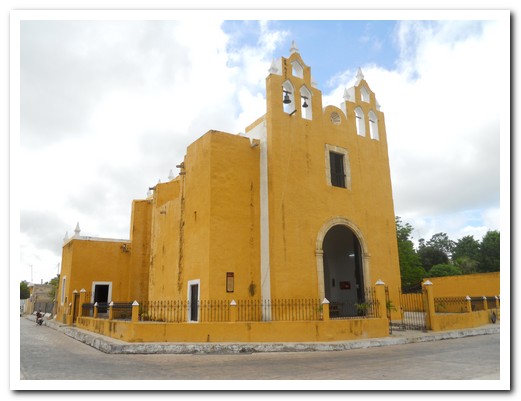
A 16 th century church in the typical very plain Franciscan style

3 amigos in the Plaza

Mérida Cathedral
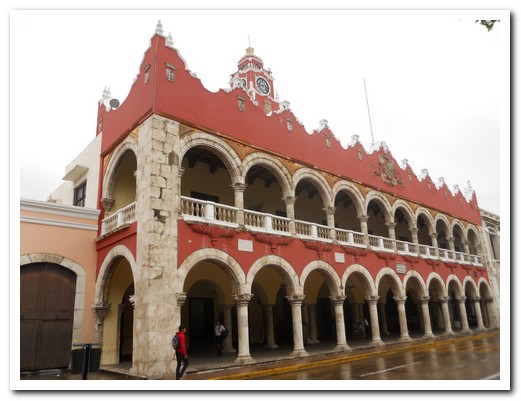
City Hall
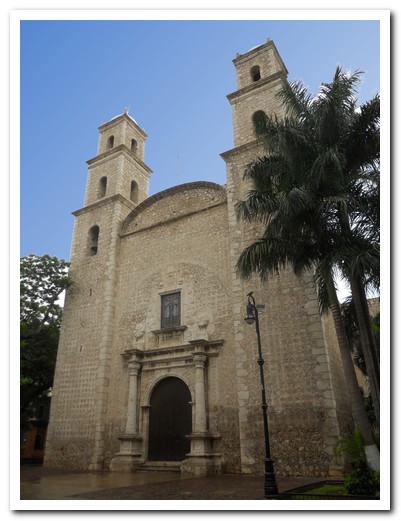
Jesuit Church, once occupied the whole block
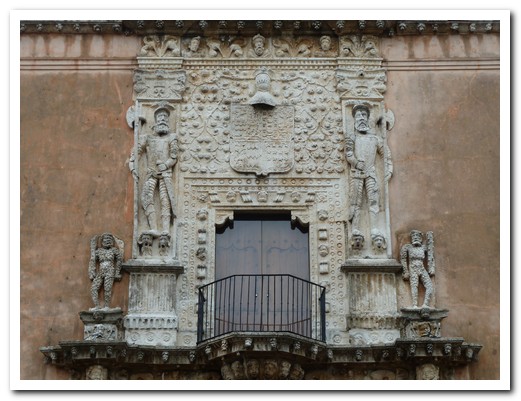
Casa de Montejo (Montejo´s House) shows Conquistadores standing on Indian´s heads

Part of the same doorway

One of the 19 th century mansions

Uxmal site
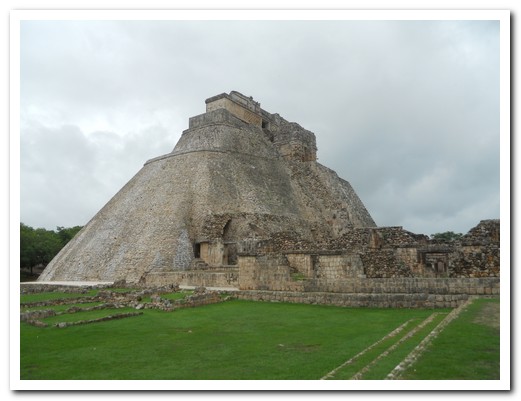
Pyramid at Uxmal

Part of the pyramid stairway

Ball court with stone hoop still intact

The longest Mayan structure, called Governor´s Palace by the Spanish
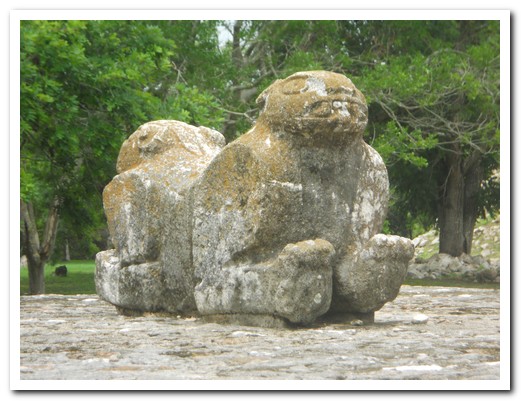
Throne

Detail of carvings
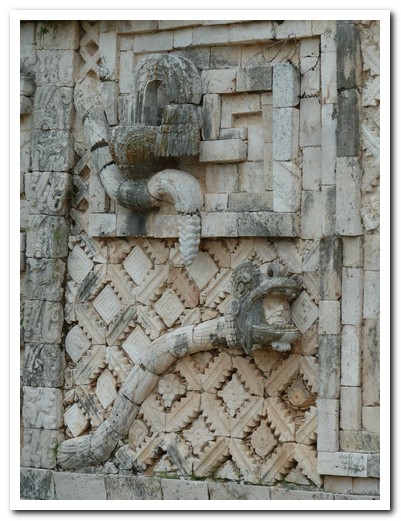
Snake - note human head in its mouth
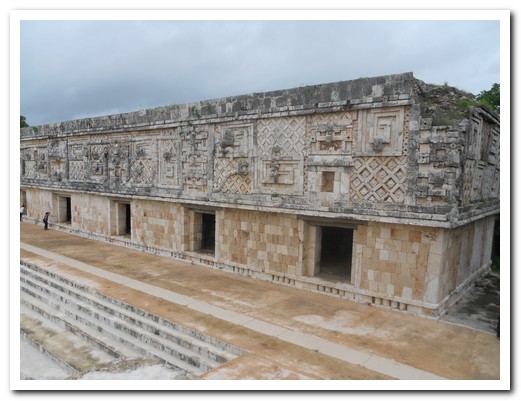
Structure
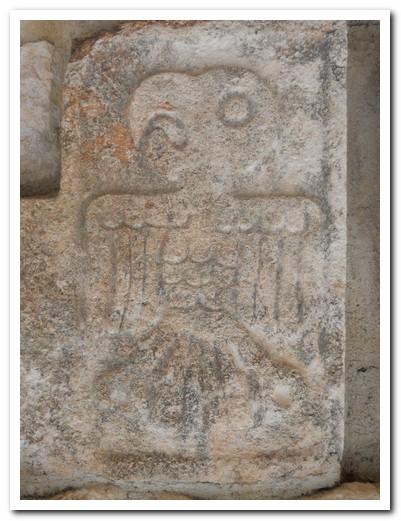
Eagle

Butterflies feeding
Valladolid
24th June 2011
Unpretentious, colonial Valladolid [5], was established in 1543 by the Spanish who built on top of a Mayan settlement. Pastel coloured buildings line wide streets, and the huge, shady square is always full of locals. It made a good base to see the nearby attractions. Valladolid is well known for its cuisine; we liked the Queso Relleno Estilo Valladolid, stuffed cheese with turkey, pork, Dutch cheese, olives, capers, almonds, raisins, and spices.
.
The closest Maya ruins are at Ek Balam, Mayan for “Black Jaguar”, dating from 300 BC. Unusually, the central religious area where the elite resided was surrounded by a double set of walls. The Mayans buried the Acropolis (160 metres by 70 metres at the base and 31 metres high), preserving the stucco sculptures and many painted hieroglyphic inscriptions. We arrived at the opening time of 0800 and had the entire place to ourselves.
.
The most famous of the Maya ruins in the Yucatan Peninsula is Chichén Itzá, listed in the New Seven Wonders of the World. Occupied until the 800´s when it was abandoned, it was re settled 100 years later by the warlike Toltecs. Thus a mixture of styles is evident. It is the best preserved and restored of all the Mayan sites and most impressive.
.
On the way back to Valladolid we stopped at Cenote Xkekén, a large underground cavern with a hole in the ceiling, for a refreshing swim in its cool clear waters. Then a taxi took us to the town of Uyama with its beautiful red, white and blue church built in 1642 from the stones of Mayan pyramids.
.
Two buses north brought us to Rio Largartos (Lizard River) [6] a small fishing village nestled in the mangroves near the coast. There are colonies of flame red flamingos and 387 other bird species have been sighted nearby. We went by boat to see the flamingos and weren´t disappointed; there were hundreds feeding in flocks. On the way we spotted a couple of crocs, eagles, herons and dozens of other birds.
.
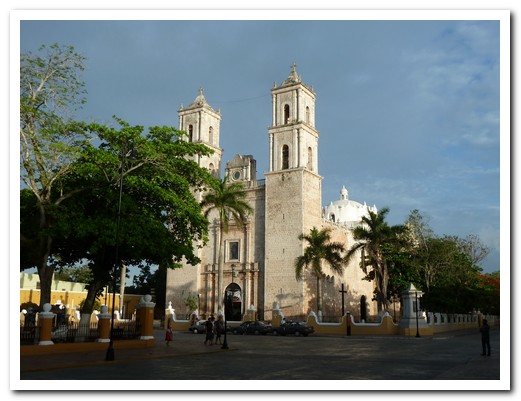
The Cathedral, built 1706 to replace the 16 th century one, on the main plaza at Valladolid
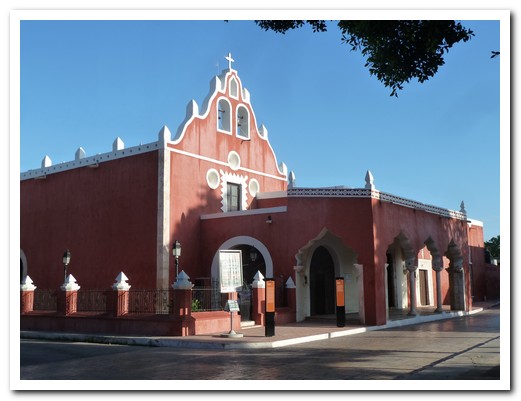
Note the mudejár style (Spanish Muslim) on this church

Calle de Los Frailes (Street of the Friars) led monks from the city centre to their Monastery
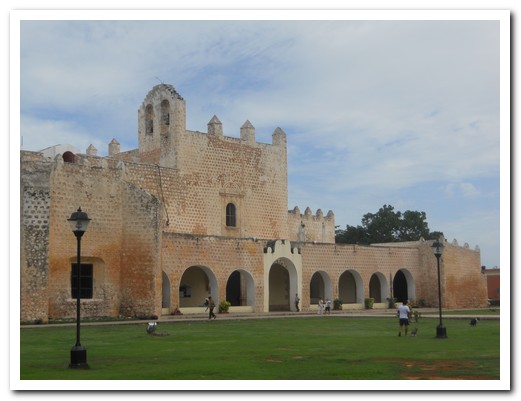
450 year old Monastery ...
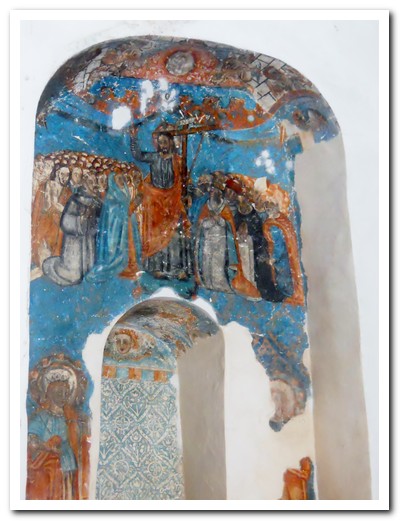
... still contains some original frescos
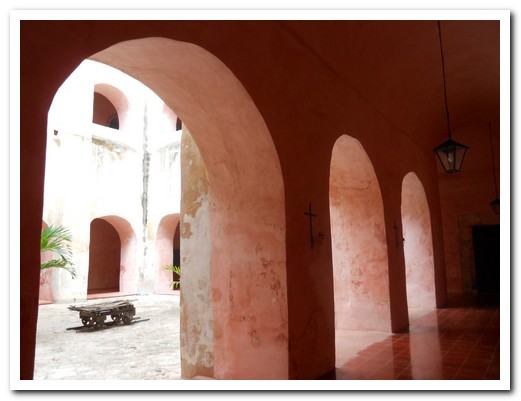
Inside the Monastery
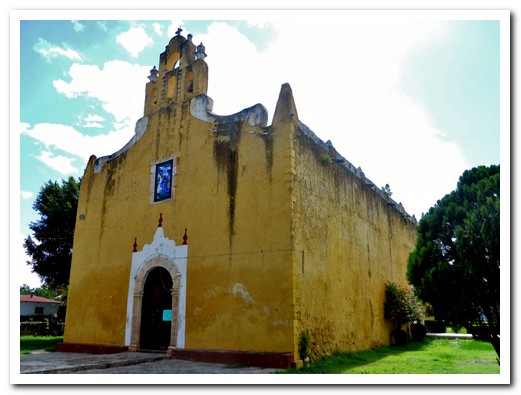
This 16th century church was for the Indians, all services in the Mayan language
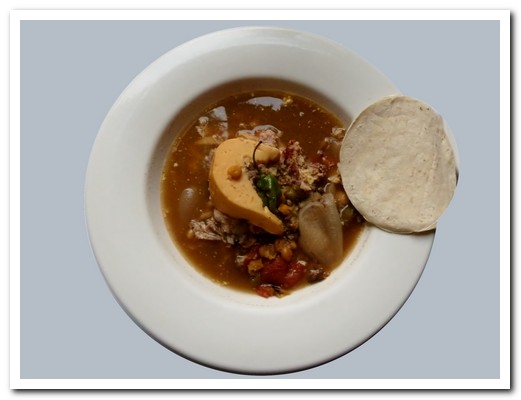
Valladolid stuffed cheese, with turkey, pork, olives, dried fruits and spices

Again the mudejár influence on this church´s bell tower
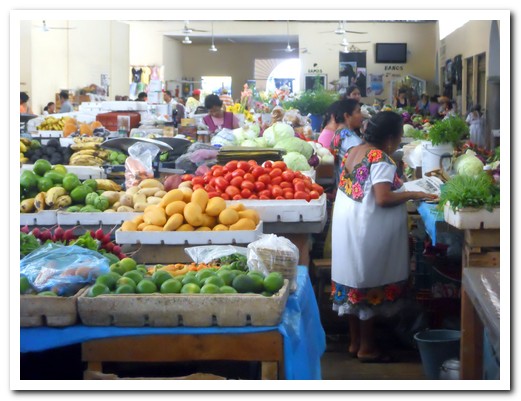
The Valladolid market

Typical women´s dresses
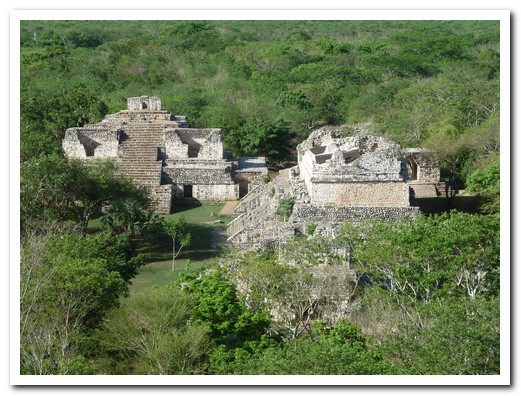
Part of the ruins of Ek Balam

More Ek Balam ruins

Carved figure on the Acropolis
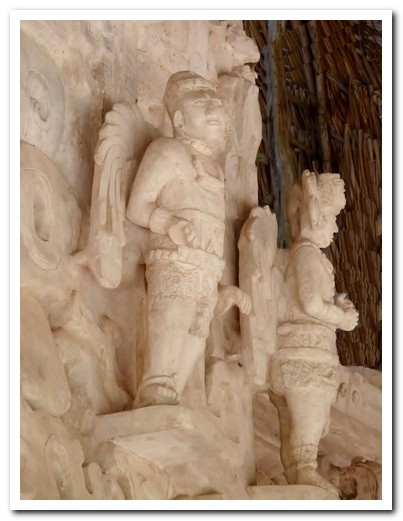
Mayan Angles (?)
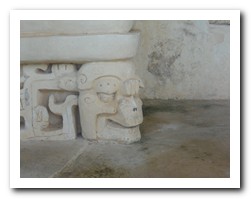

| Details of head masks at Ek-Balam |

Mayan lady sleeping on the bus
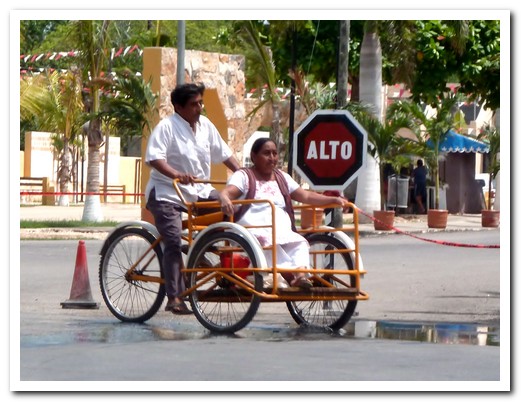
Bici taxi
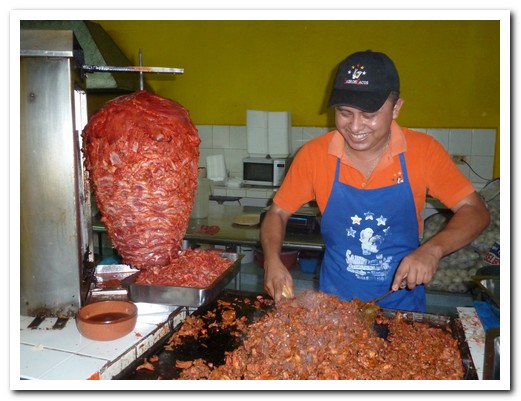
Take slow cooked pork ...
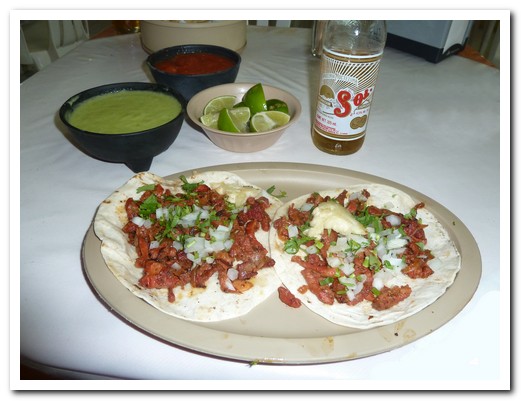
... put it on a taco with pineapple, and you have taco al pastor
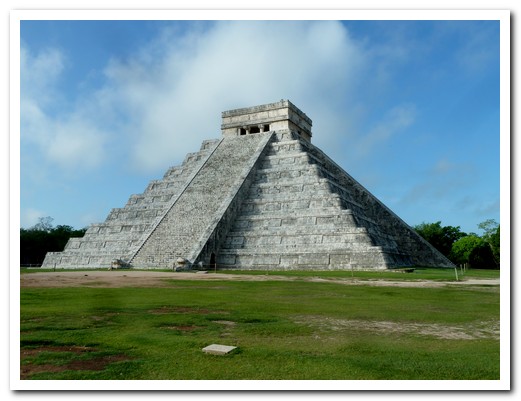
Central pyramid of Chichén Itzá
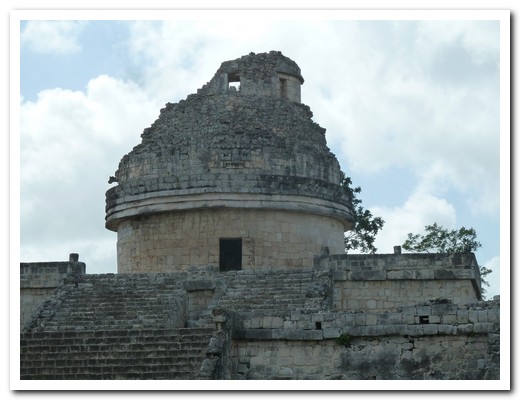
The Observatory - windows line up with certain stars
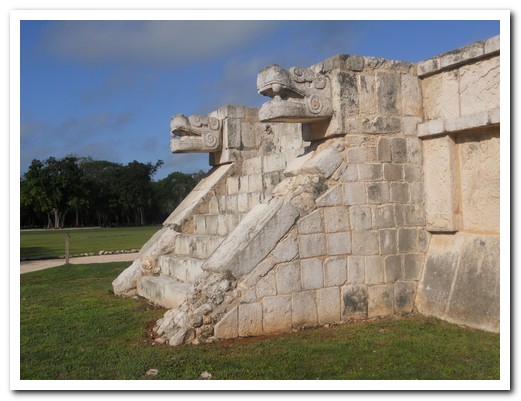
Platform of the Eagles and Jaguars (Maya/Tolmec)
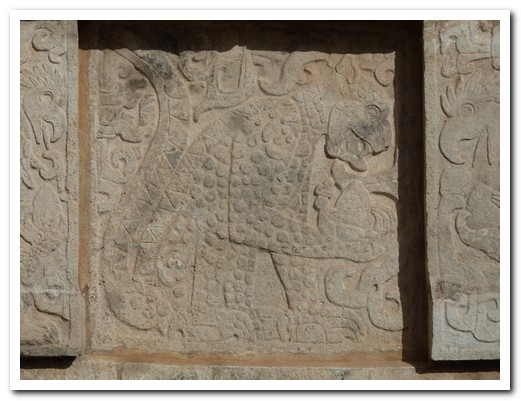
Jaguar eating a human heart

Platforms of skulls had real human skulls of the sacrificed on the platform

Plaza of the thousand columns
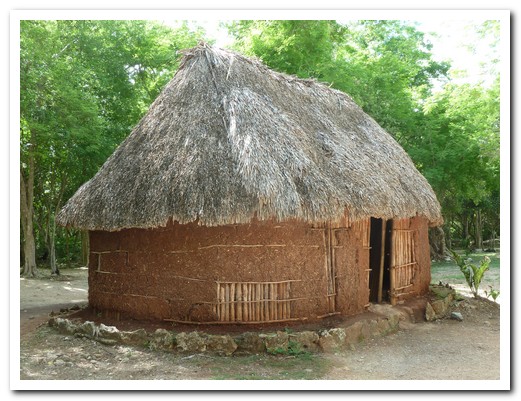
Mayan hut
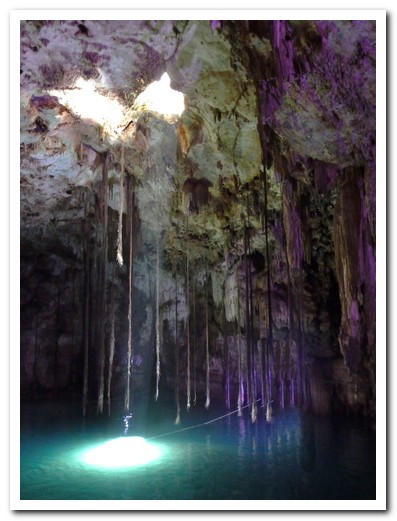
Cenote Xkekén - tree roots seeking the water

Pam cooling off in the cenote

The 1642 Iglesia Santo Domingo at Uyama, made from stones from Mayan pyramids
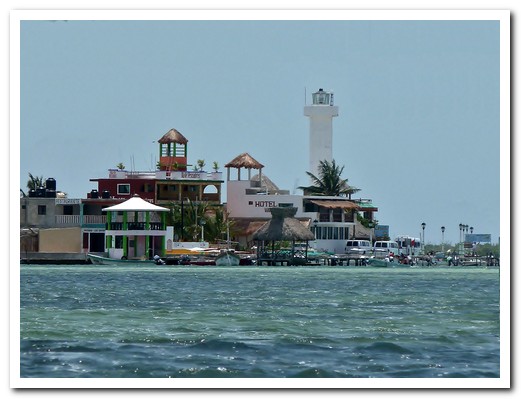
Rio Largatos
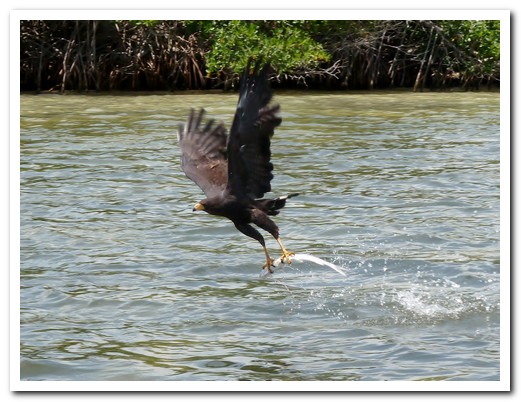
Black Hawk catching a fish
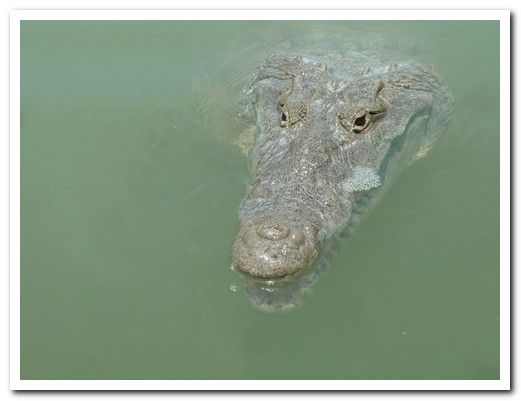
A crocodile came right up to our boat

Spoonbill
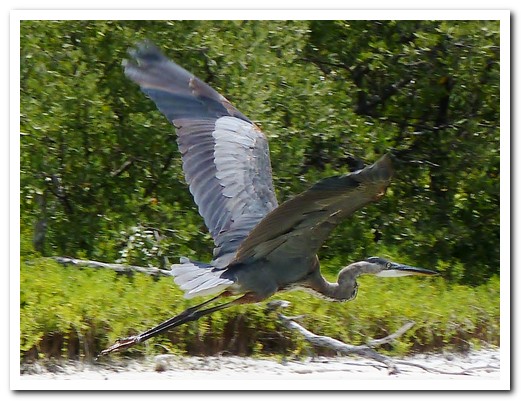
Grey Heron in flight
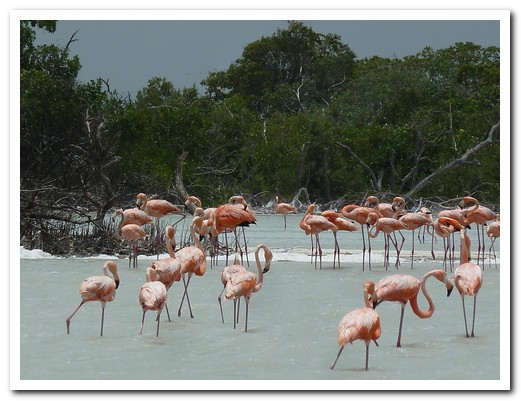
Flamingos feeding
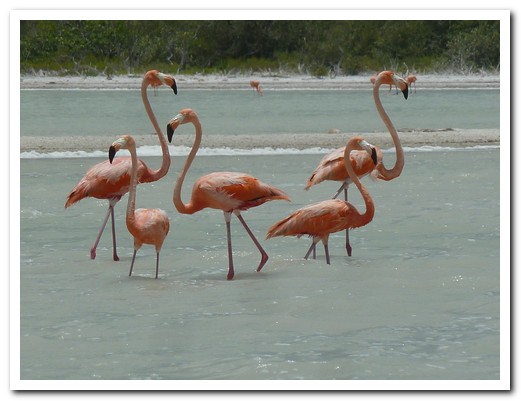
Flamingos
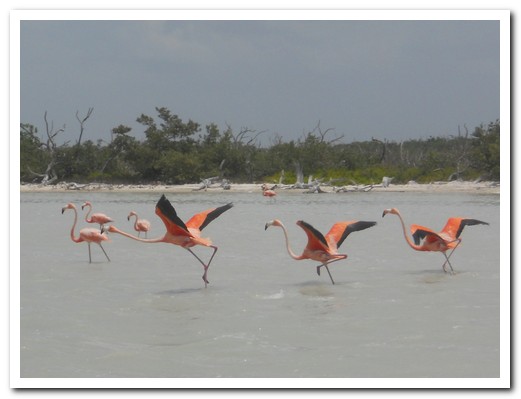
Taking off
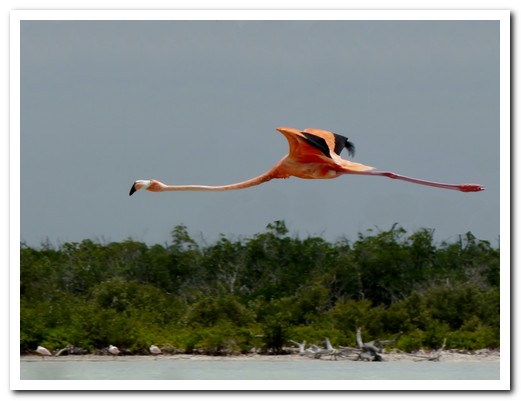
Airborne
Caribbean México
21st June 2011
The ruins at Tulum [3] may be modest but the setting on a cliff above the ocean, grand. It was occupied between 1200 AD and 1521 AD, at the end of the Mayan civilization. On borrowed bikes from the hotel we peddled out early to avoid the heat and the hordes.
.
Around Tulum there are many cenotes, sections of caves that have collapsed leaving behind round sinkholes filled with clear, cool water. No need for a mask and snorkel, the water is crystal clear and the underwater wonderland of stalactites and stalagmites is clearly visible. The Maya believed cenotes to be entrances to the underworld.
.
Bypassing the “planned paradise” resorts of Cancún, we took the fast ferry out to Isla Mujeres (Island of Women) [4] on a rainy, windy day. After 2 days the weather improved and we were able to head northeast into the open sea, an hour in a small boat doing 20 knots, to snorkel with the whale sharks. Scarcely able to believe it, a school of about 200, average length 10 meters, circled around our boat. Into the deep ocean we went, nervous as the gentle giants approached within a meter of us, mouths wide open, cleaner fish attached to their gills. It was an incredible experience. Back on board the sea was getting rougher with a choppy meter high swell – everyone threw up.
.

Ruins of Tulum overlooking the Caribbean
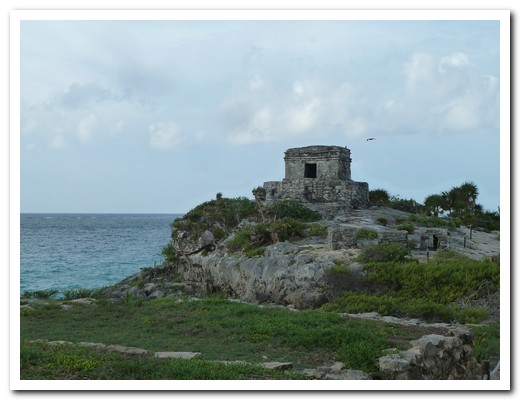
Tulum was a major Maya port - large boats ventured as far south as Honduras

Tulum Temple - the crooked angles are deliberate, not the result of 2000 years weathering
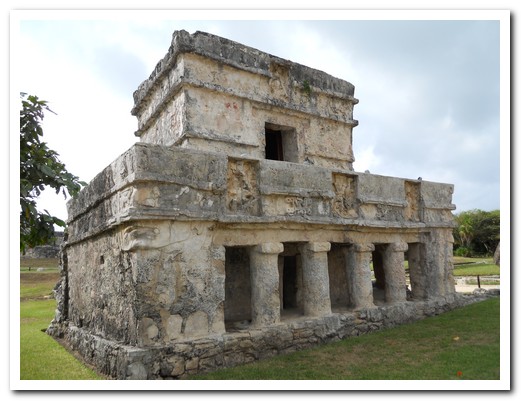
There are still mosaics on the inside walls

Pretty black and blue bird at the site
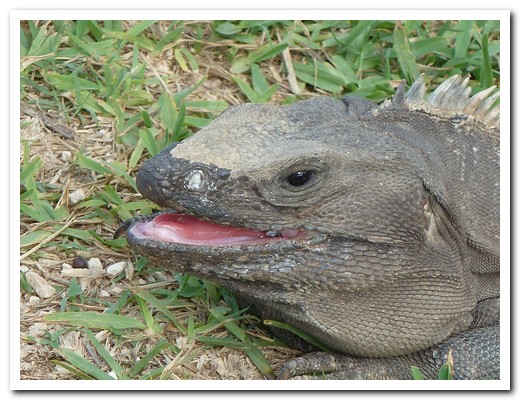
Iguanas are all over the Tulum ruins
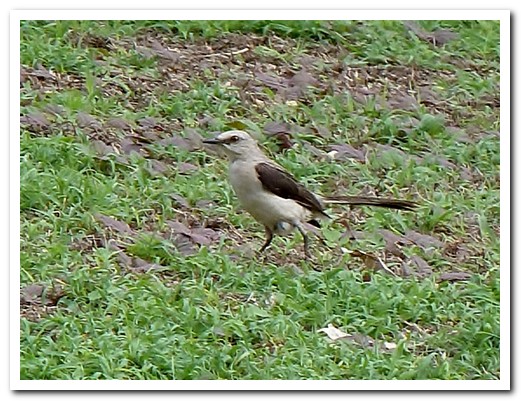
A little bird
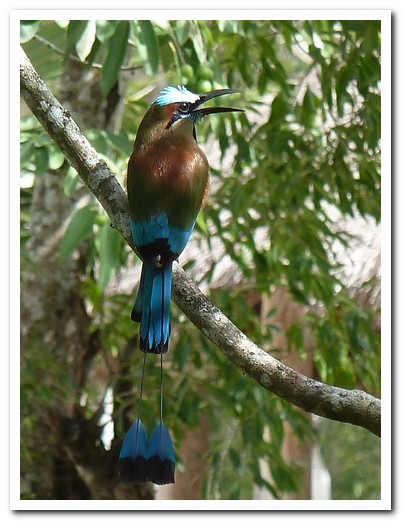
Long tailed bird
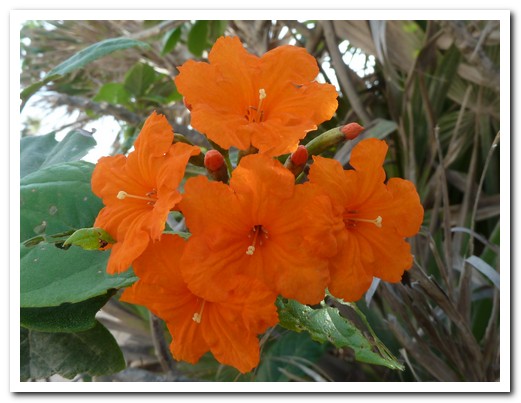
Orange flowers
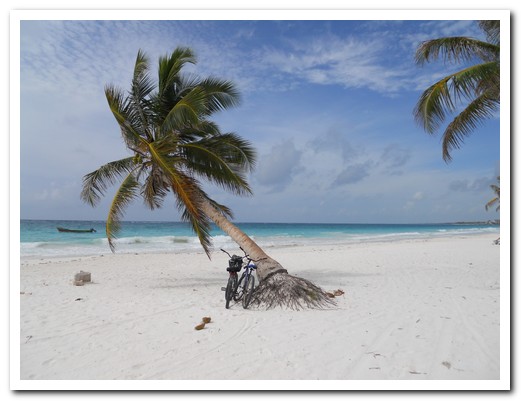
We rode bikes to the beach
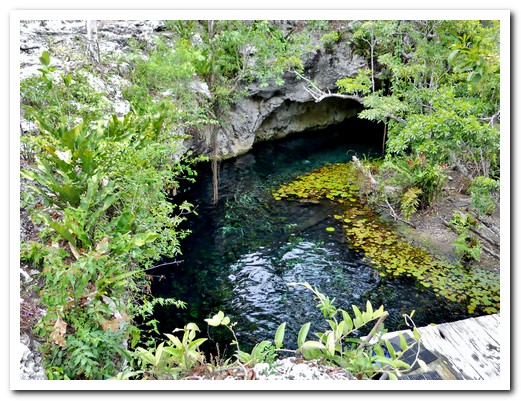
Cenote Grande
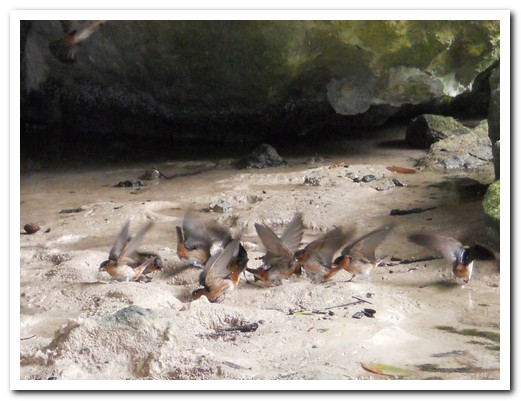
Little birds eating limestone in the cenote

The water is so clear ...

... you can see the stalactites under the water
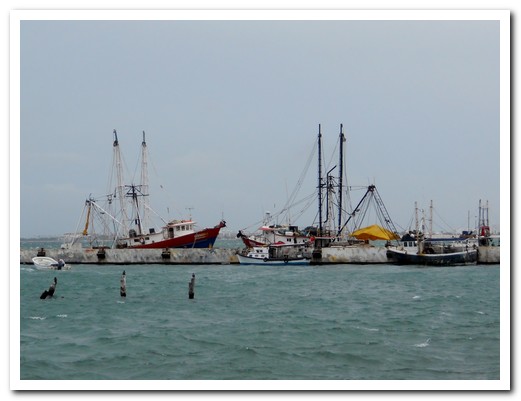
Fishing boats at Cancún

Margaritas on the beach at Isla Mujeres
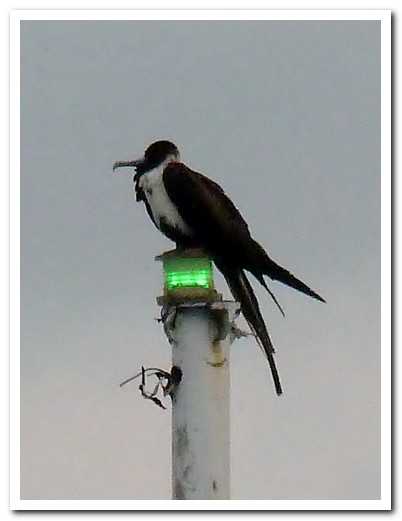
Frigate bird likes this light pole
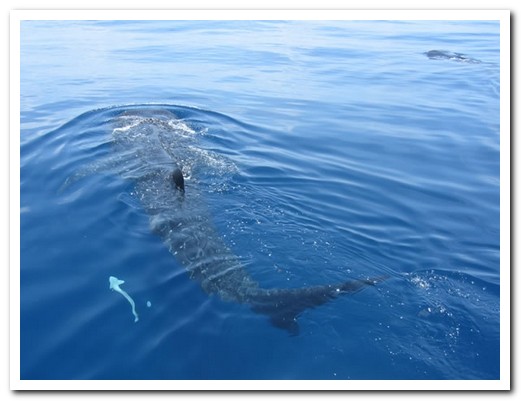
The Whale Sharks are bigger than the boat
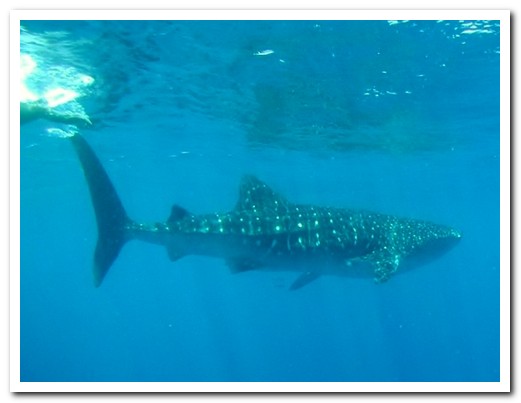
Someone´s photo underwater

Post swim ceviche - just what we needed after throwing up
México at Last!!!
17th June 2011
México at last!!!
.
We began in Chetumal [1], just over the border from Belize, with a visit to the “must see” Museum of Maya Culture. The Yucatán Peninsula is dotted with the remains of grand Maya cities so we headed inland to the small village of Xpujil [2] to see the ruins of Xpujil. A large structure topped by 3 towers dominates the site.
.
Becán (550 BC – 1000 AD), a few kilometres away, is surrounded by a moat, unique in the Mayan cities. We had the ruins to ourselves surrounded by only the jungle and its eerie early morning sounds.
.
The vast World Heritage site of Calakmul sits within a biosphere reserve. Our guide Nicolas (Kaan Expeditions) pointed out birds and animals along the way. Being hard to reach there were very few other visitors. The tallest 82 metre high building towers over the trees that surround ancient temples. The city flourished from 250 AD to 695 AD and some of the structures still have wooden beams from those times. We tried to picture the city as it once stood, brightly painted stucco covering huge pyramids which surrounded large paved plazas.
.

Statue in Museum of Maya Culture In Chetumal
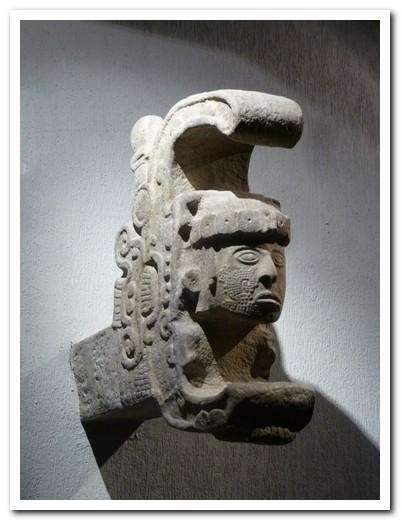
Part of a Mayan Temple in the Museum
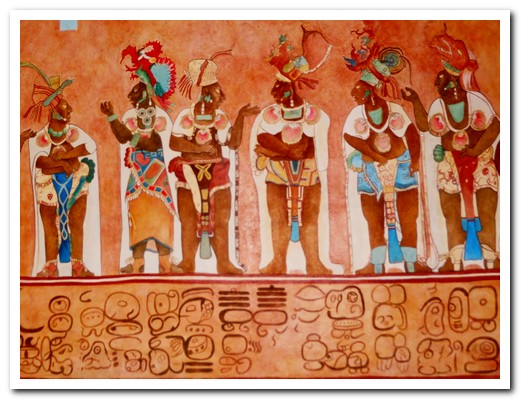
This shows how the inside walls were decorated ...
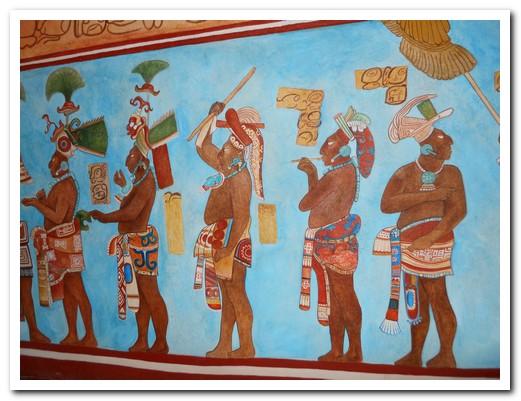
... in vibrant colours

Breakfast tamales sold beside the road at Xpujil

3 towered structure at the Xpujil site is atypical - normally only 2 towers were used
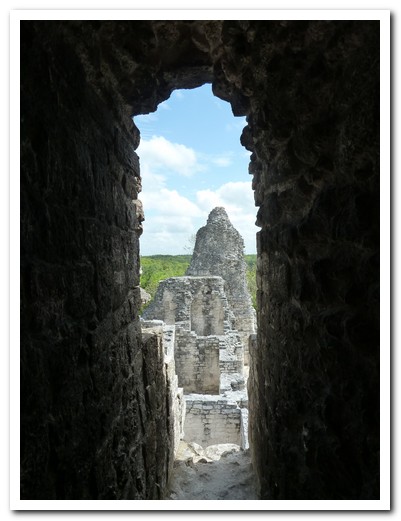
View of one tower through a Mayan arch
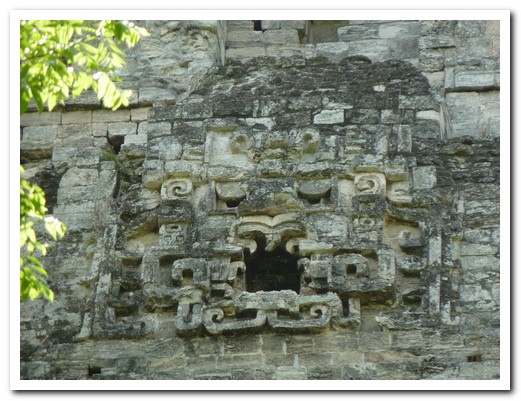
Jaguar mask on the back of the central tower
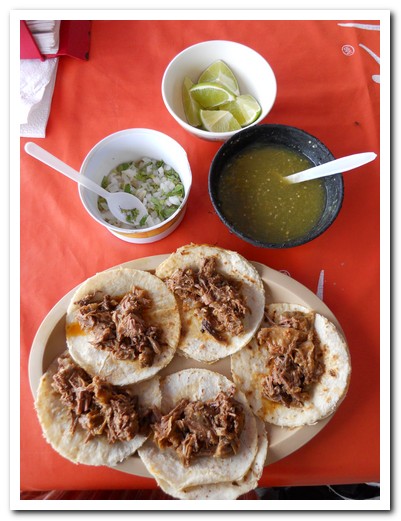
Simple roast meat taco with green hot sauce and lime - yum!
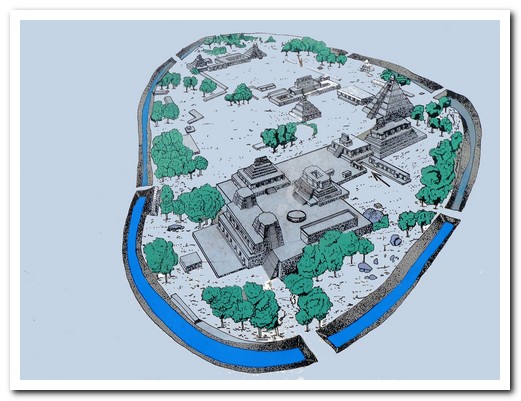
Becán was surrounded by a moat - unique in the Mayan world
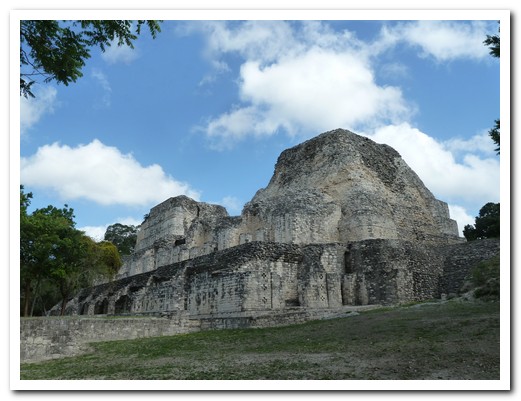
2 towered structure
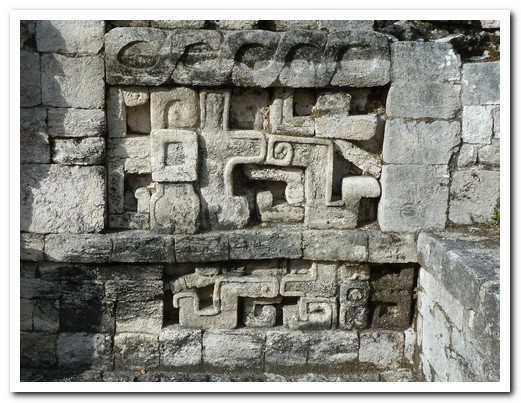
Representation of a snake on a Becán building
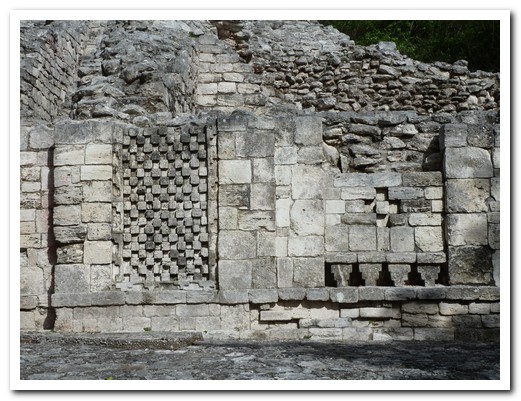
Typical Rio Bec style detail on a Becán building
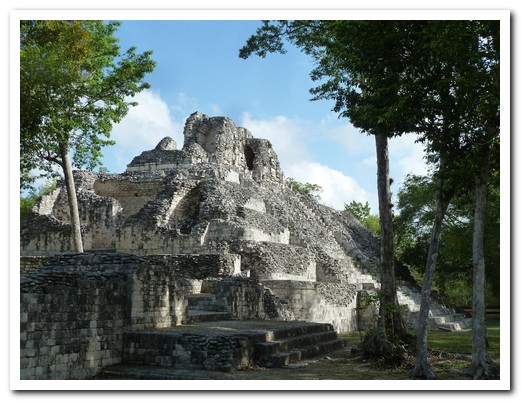
Rounded corners and well made blocks of the Rio Bec style
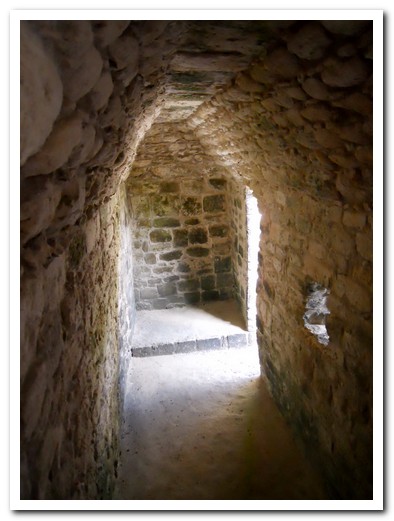
Corbelled arch is seen in all Mayan structures
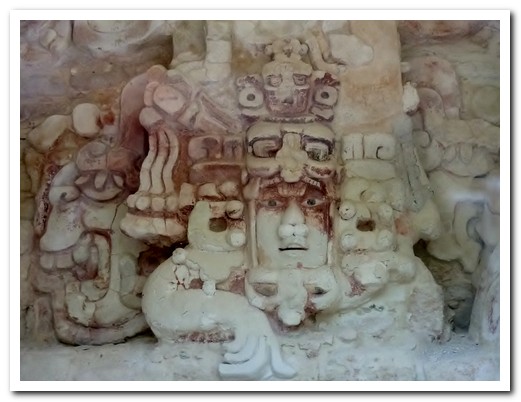
Original fresco on an interior temple has traces of red paint
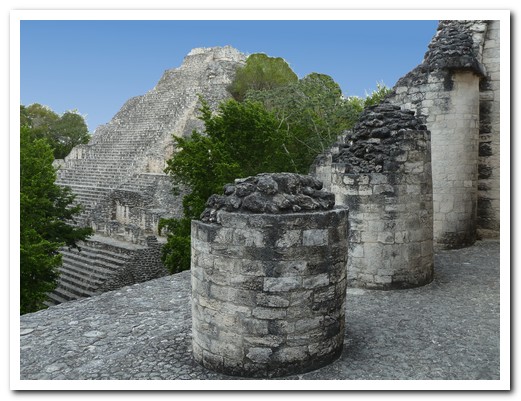
Round columns were unusual
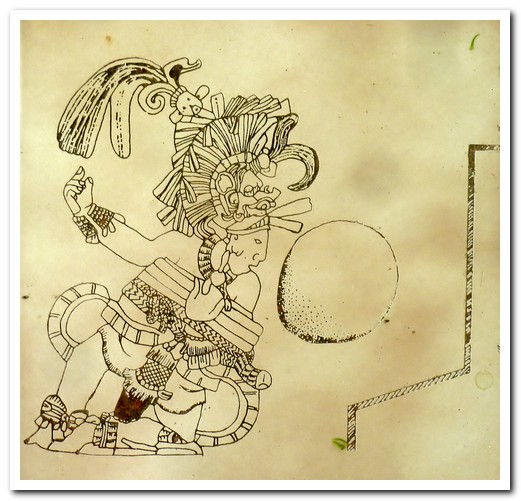
Depiction of the ancient Mayan ball game ...
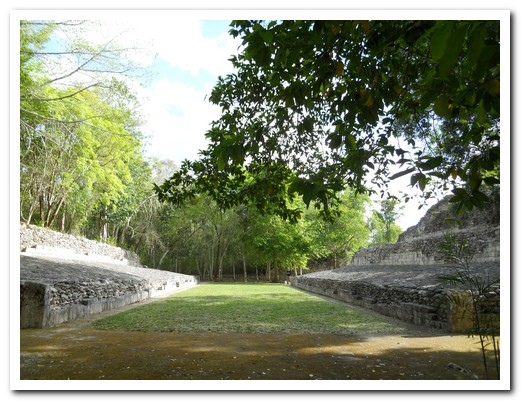
... played in this ball court

Keel Bill Toucan in the Calakmul Biosphere Reserve
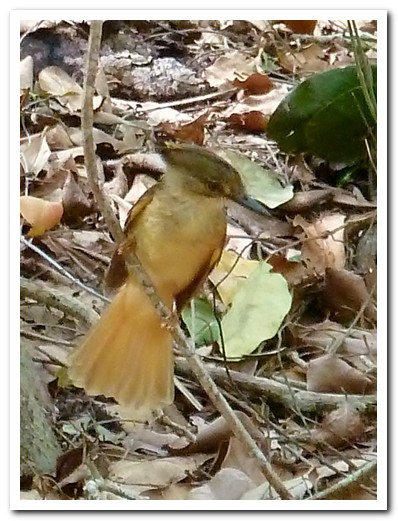
A rarely seen Royal Flycatcher

Tortoise

Roadside Hawk with prey
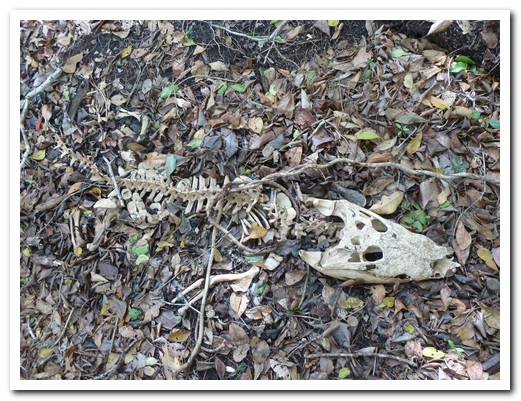
Skeleton of a crocodile, probably killed by a jaguar
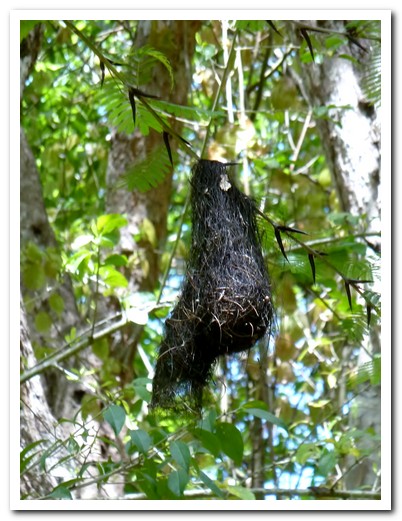
Hanging nest of the Oriel bird opens at the bottom
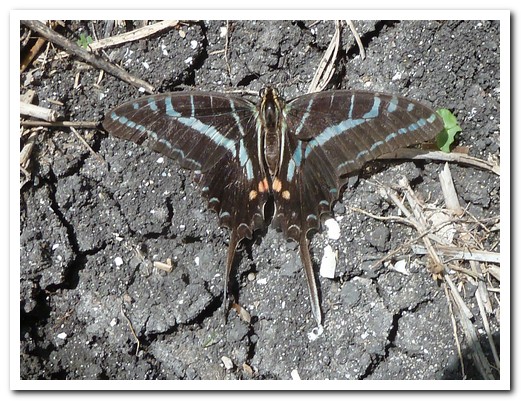
Butterfly
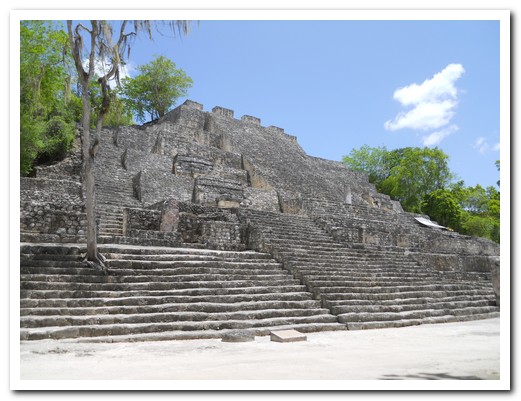
Main structure at Calakmul at 82 meters high - you cannot see the top temple from below
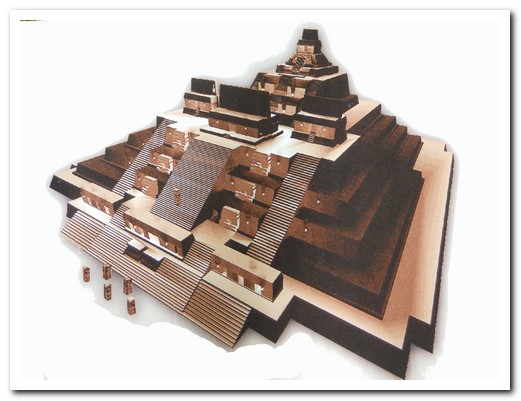
Diagram of the structure
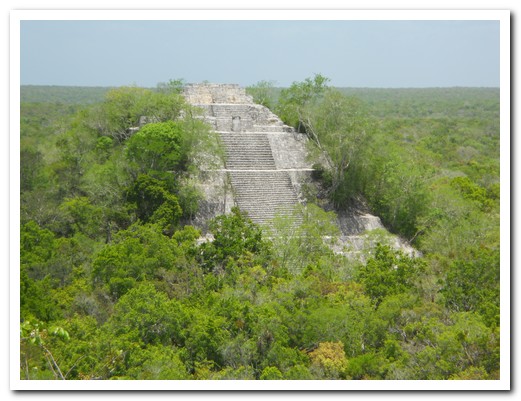
A temple rising out of the surrounding jungle

Leaning stela in the forest

This building was found just as it is at Calakmul - it has not been restored

Stepped pyramid (Calakmul) - various layers evident
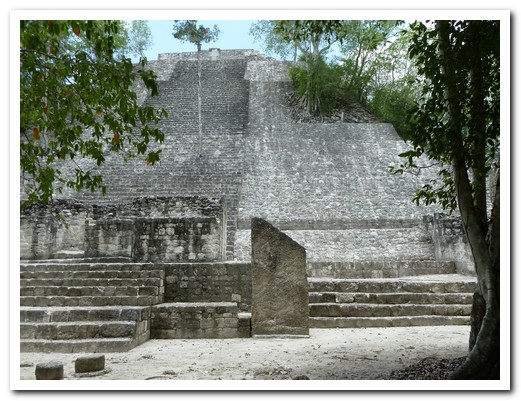
Another structure at Calakmul
 |
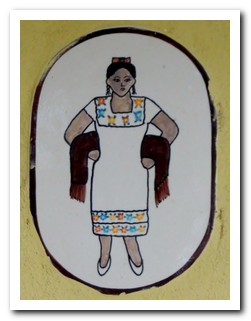 |
| Mens and Ladies baños (toilets) |
Mayan Belize
12th June 2011
Leaving the coast behind we headed inland to San Ignacio [6] for the Maya ruins of Caracol. With experienced guide Elias Cambranes of K’Atun Ahaw Tours we were able to understand more about the earliest inhabitants. It is believed that more than 1 million Maya once lived in what is now Belize (present population 321,000). Extensive ruins can be found right across the country.
.
Caracol was once one of the largest city states. The centre piece of the site is the 43 metre high structure known as Caana (Sky Palace) topped with 3 temples. There is a great view of the rest of the site from the top.
.
Caves, representing the underworld were important to the Maya. Rituals and human sacrifice was performed deep inside. A tour of Actun Tunichil Muknal (ATM) Cave was certainly an adventure. We swam into the dark mouth of the cave then slowly scrambled over rocks, waded through water and squeezed through narrow spaces some 800 metres into the 5 kilometre long cave. We then left the water by climbing up the rocky wall to reach a large chamber filled with spectacular stalagmites and stalactites. The floor was littered with pottery vessels placed there over 1 thousand years ago as well as human remains. Everything lies where it did when the Mayas left – nothing has been removed. The most interesting was a complete calcified skeleton of a woman (the crystal maiden) tucked away in small cavern.
.
Further north from the town of Orange Walk [7] we travelled by boat down the New River to the Maya site of Lamanai (Submerged Crocodile). Jungle overhanging the river banks was reflected in the inky black water, crocodiles were sunning themselves on tree trunks, a spider monkey swung through the trees following the boat and water birds were everywhere. Lamanai was one of the largest and longest inhabited ceremonial centres in Belize.
.
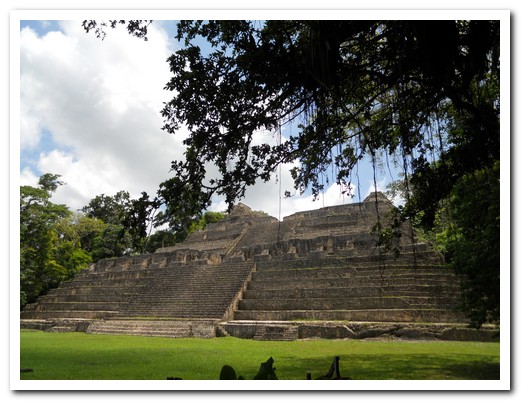
Caana, the main temple at Caracol, is the largest building in Belize
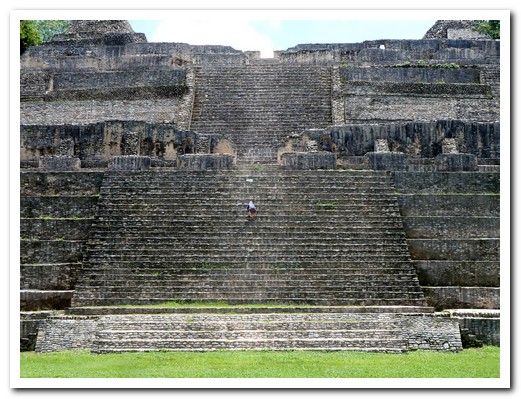
Pam climbing the 43 meters to the top
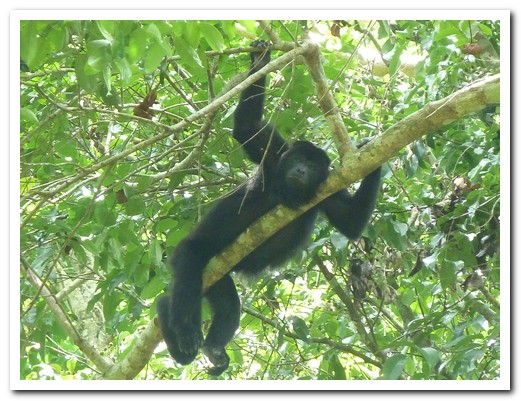
Black howler monkeys in the park

One of the temple on top of Caana
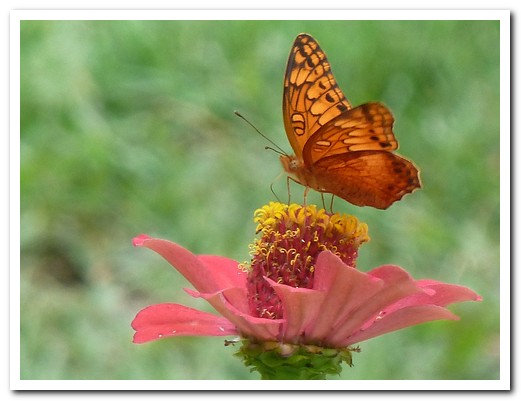
Beautiful butterfly

Jeff is almost there – great view of a pyramid behind
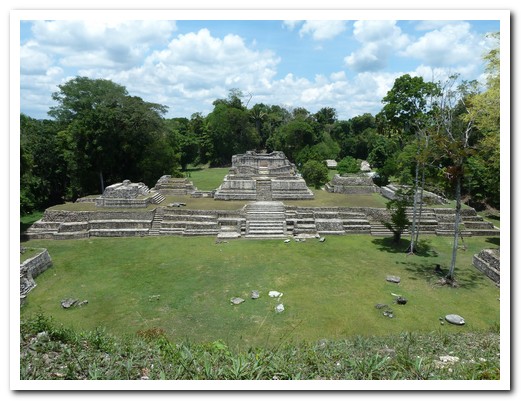
The Mayan observatory shows the equinox alignments
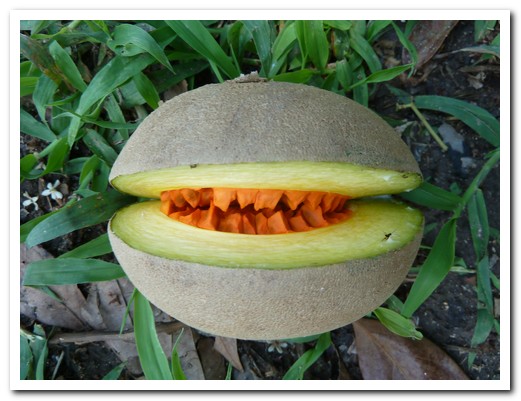
Monkeys love this fruit
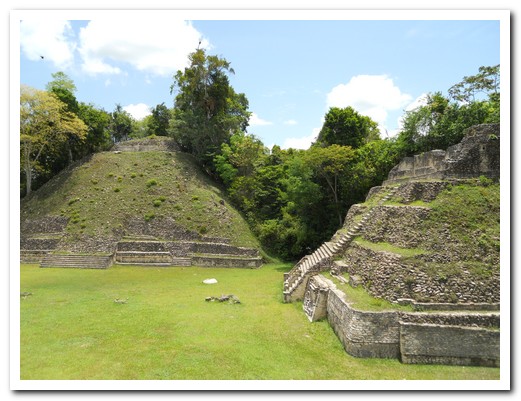
Other ruins
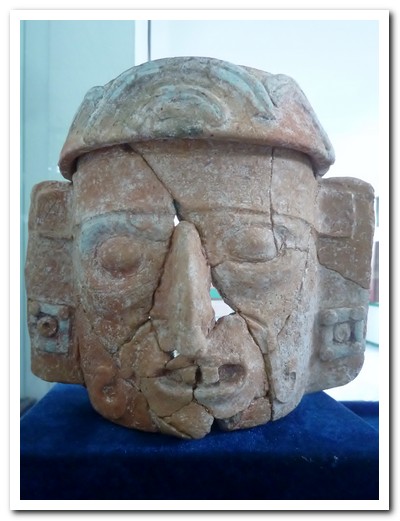
Ceramic jar used for offerings
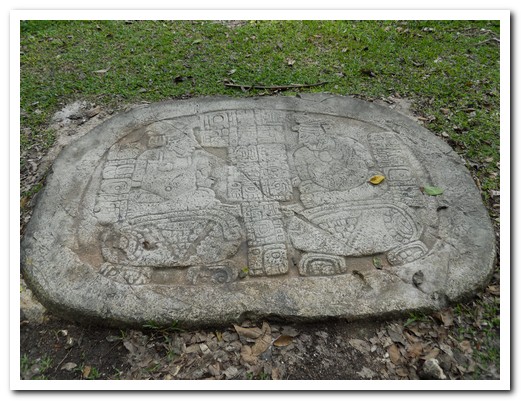
Altar
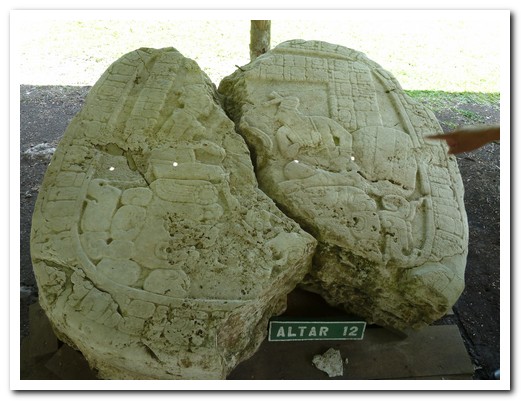
Altar
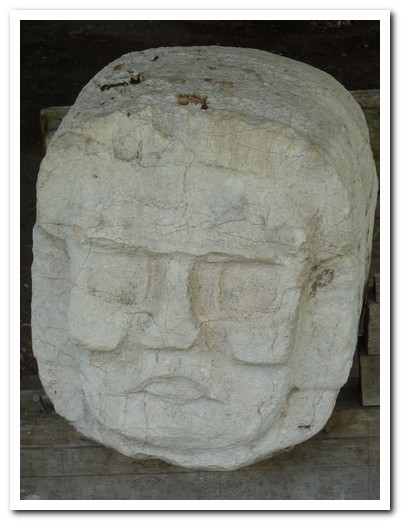
Carving of a head
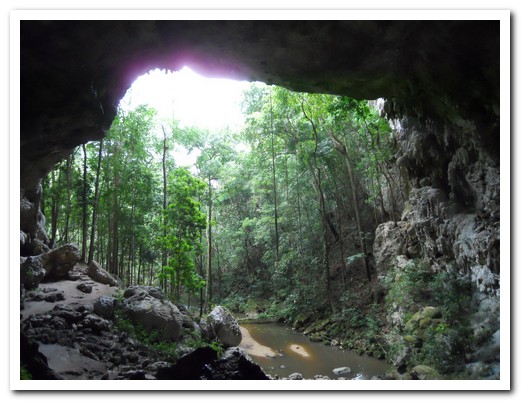
Entrance to the Rio Frio (Cold River) Cave

Exit to the Rio Frio Cave
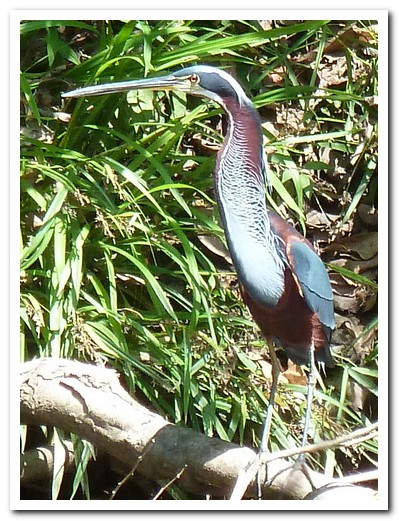
Heron
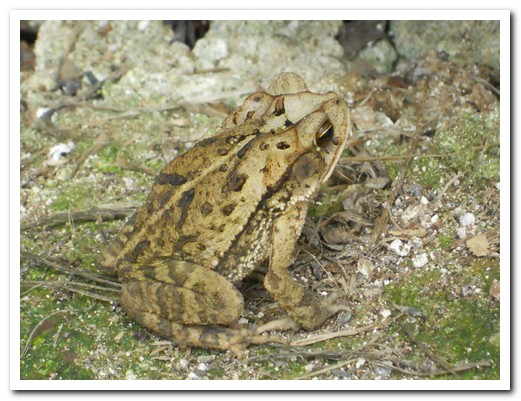
Frogs were out – the rains are coming
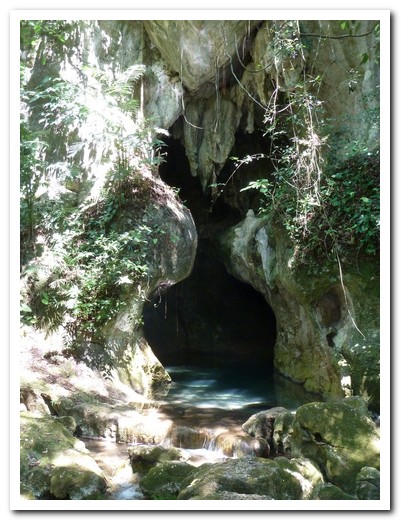
We swam in through the entrance of the ATM Cave
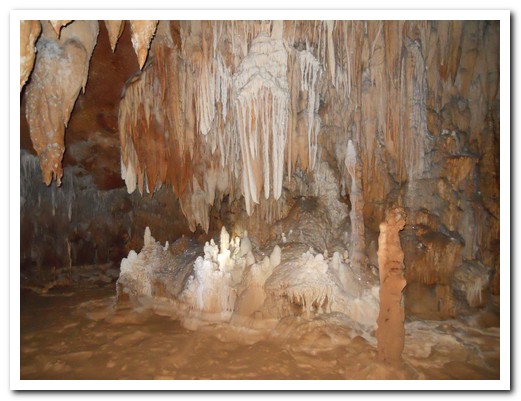
Inside the cave dry chamber ….
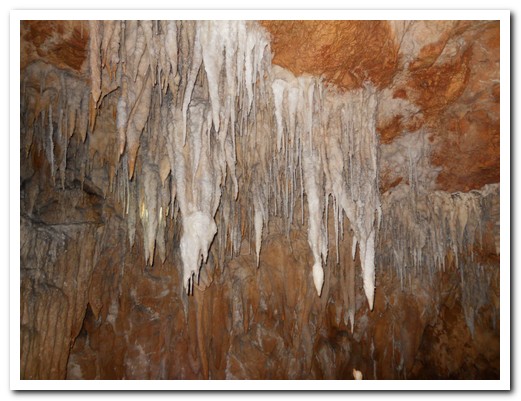
… are beautiful formations
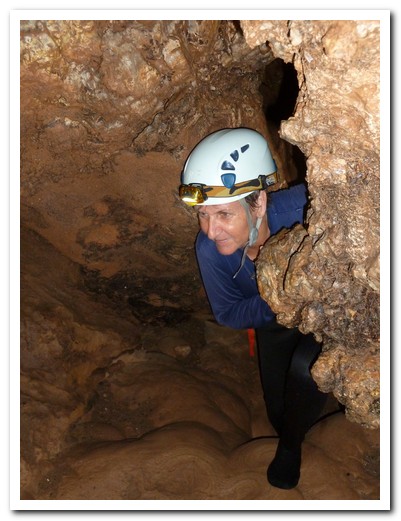
Pam squeezing through a hole – she really did go inside a cave!
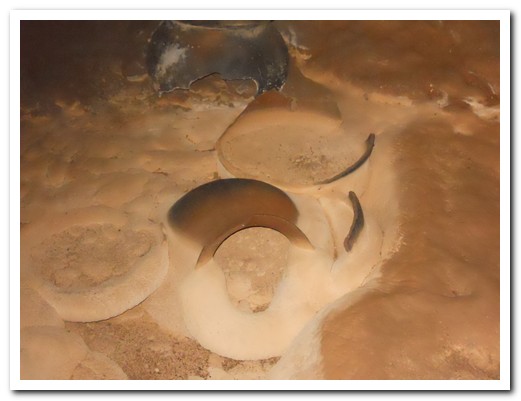
Pottery calcified from years in the cave
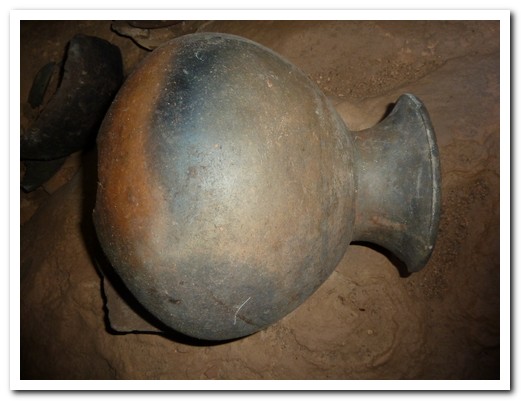
Ceramic urn lying on its side with …
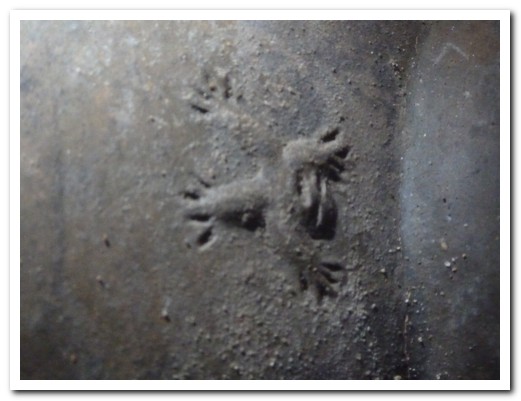
… a small trademark
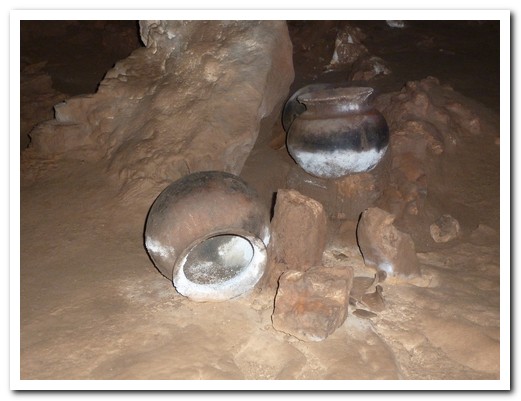
Pots in an ancient fireplace
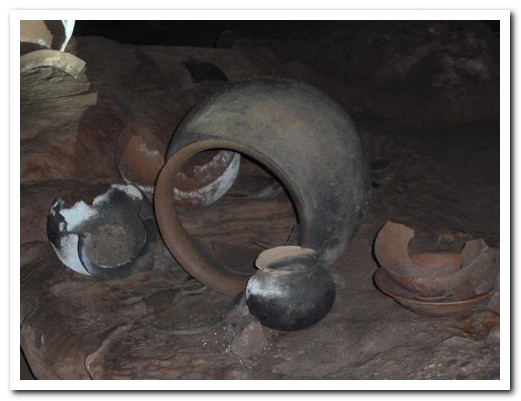
Pots were broken as part of a Mayan ceremony
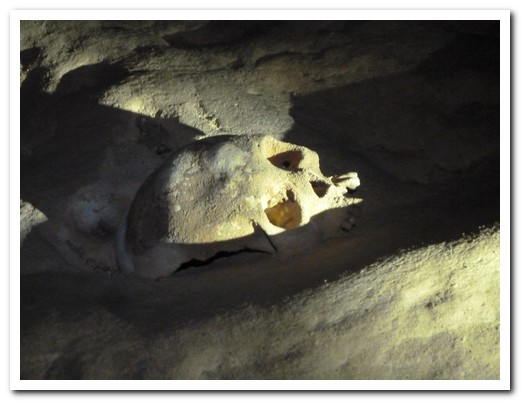
Skull shows signs of deliberate deformation
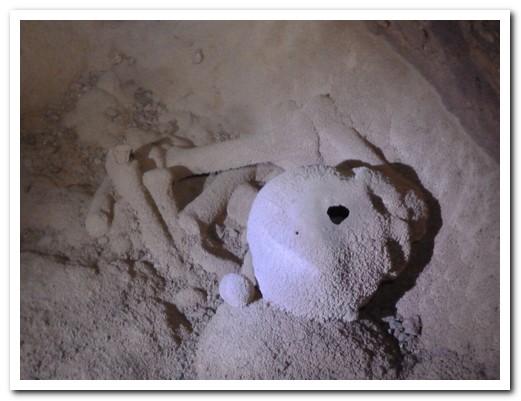
Bones from a human sacrifice, note the hole in the skull
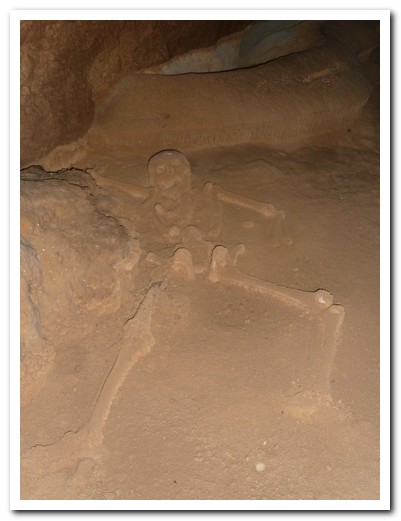
The crystal maiden, calcified to the cave floor, was the highlight
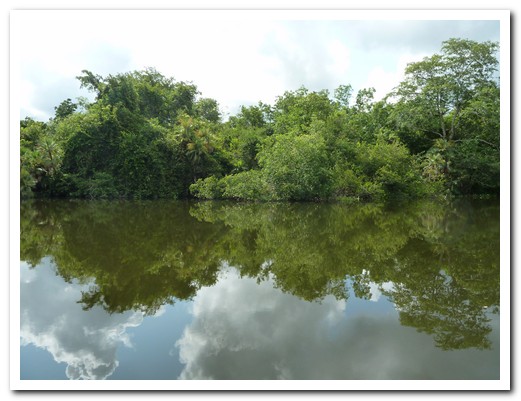
The New River from Orange Walk to Lamanai
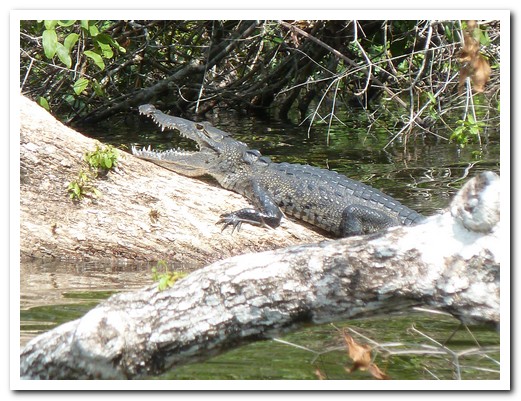
Crocodile sunning itself

Waterlillies
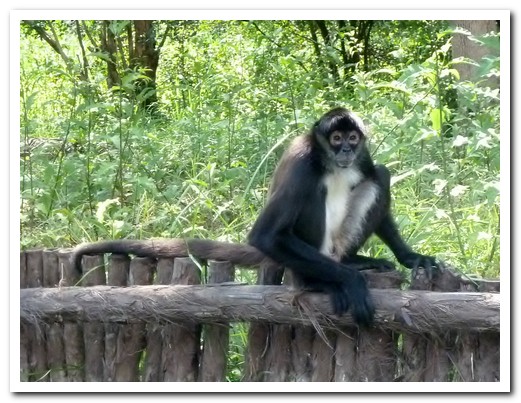
Spider monkey
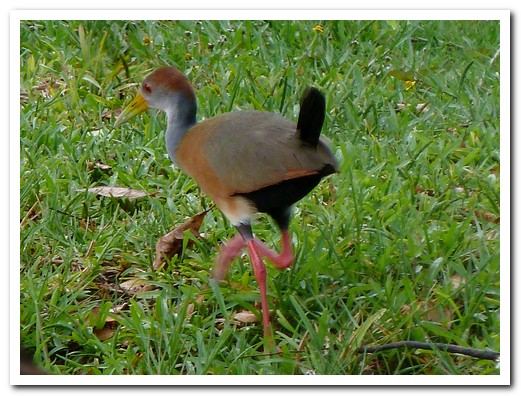
Grey breasted wood rail
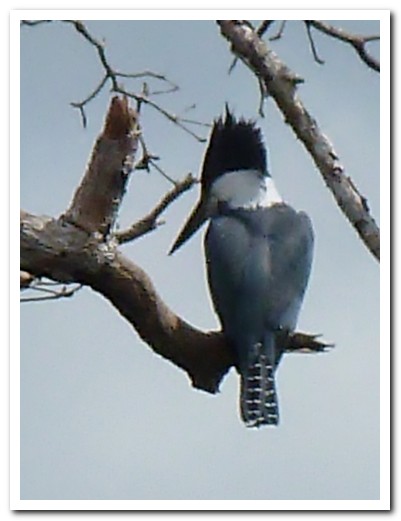
Kingfisher

Tiny bats
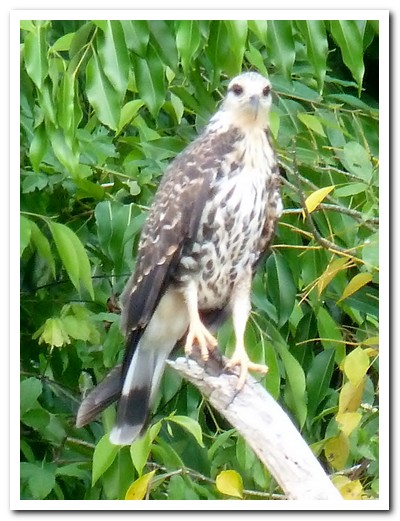
Snail kite
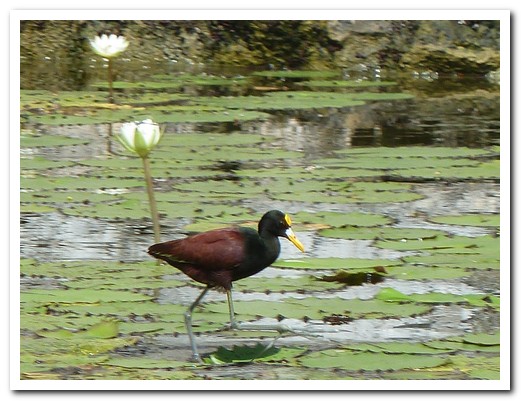
Jacana
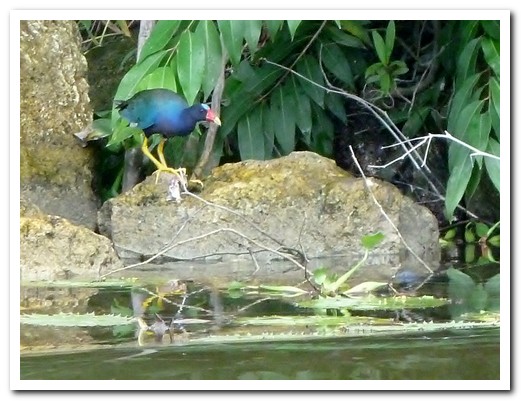
Water bird
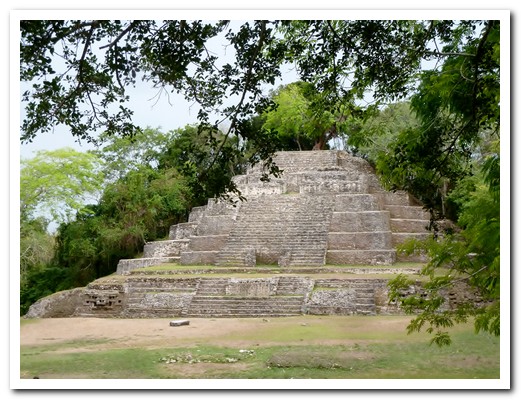
Jaguar Temple at Lamanai
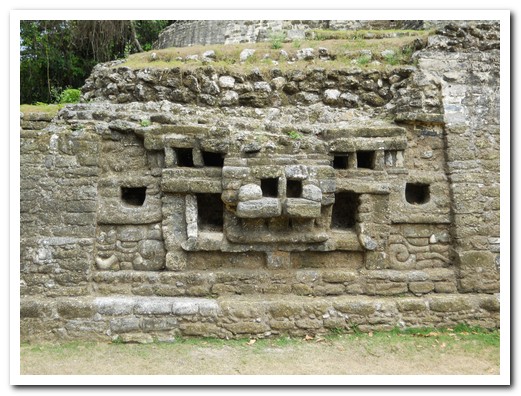
Jaguar on the Temple
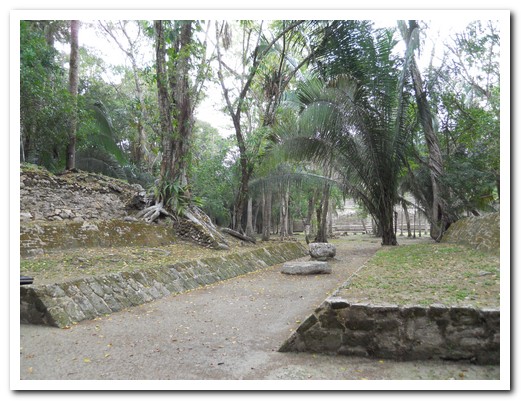
Ball court, the winner gets sacrificed
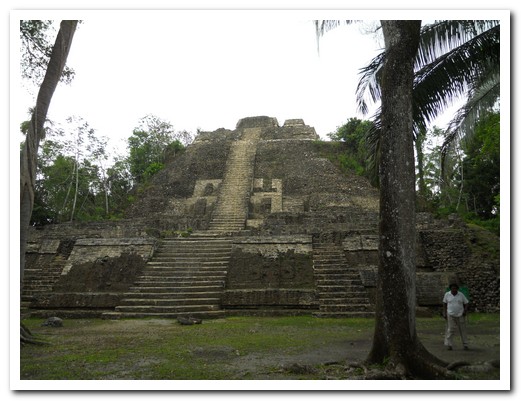
High Temple (33 metres tall)
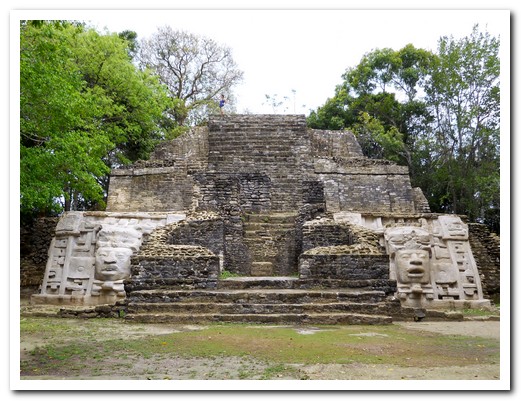
Mask Temple
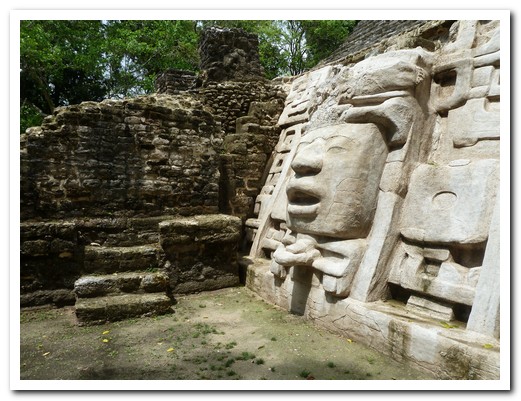
Masks – over 2 metres high, the biggest in the Maya world
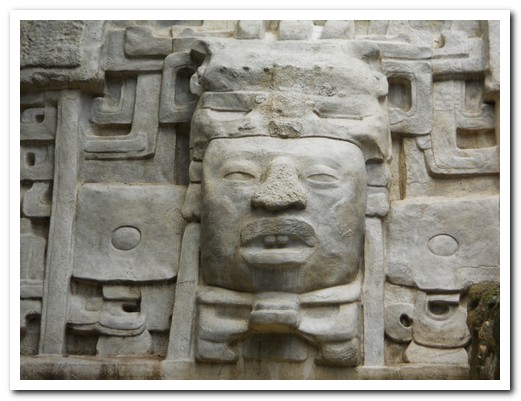
Masks show Olmec characteristics
Belize Coast
08th June 2011
From the cool Guatemala highlands we flew to hot, humid Belize on the Caribbean. Once a British colony (and a haven for English pirates), Belize is a primarily English speaking country. The Maya were the first inhabitants and together with an interesting mix of Creoles (African/European), Mestizos (Spanish/Maya) and Garifuna (African/Caribbean) plus a few Chinese, Indians and Mennonites make it quite a different country to the rest of Central America.
.
We spent a night in Belize City [1] before catching the water taxi to Caye Caulker [2], a super laid back island 3 blocks wide and 3 kilometres long with sandy streets and only a few cars.
.
Belize has the world´s second largest barrier reef dotted with some 200 islands or cays. We took a 3 day trip on the 40 foot gaff rigged, traditional Belizean wooden sailing boat, Ragga King, heading south from Caye Caulker to Placencia [5], reggae music blaring. There were 11 of us tourists, plus 2 crew on board. Patrick, the skipper, was an expert spear fisherman while the first mate and cook Shane kept us amused with his antics and singing. Sailing between islands through aqua blue water, we stopped every couple of hours to snorkel on shallow patches of reef. Under water was a different world – beautiful corals and fish we´ve not seen before. We were thrilled to see a manatee glide by. The first night we pitched our tents on the deserted Rendezvous Caye [3] a tiny sand patch with 5 coconut trees, the second night on sandy Tobacco Caye [4]. Dinner was the fish caught each day washed down with a few rum punches whilst sitting around a campfire.
.
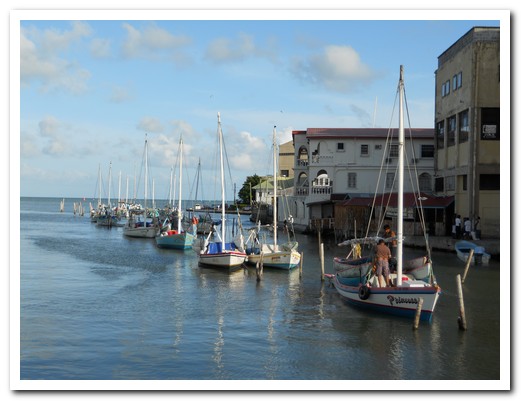
Belize City harbour
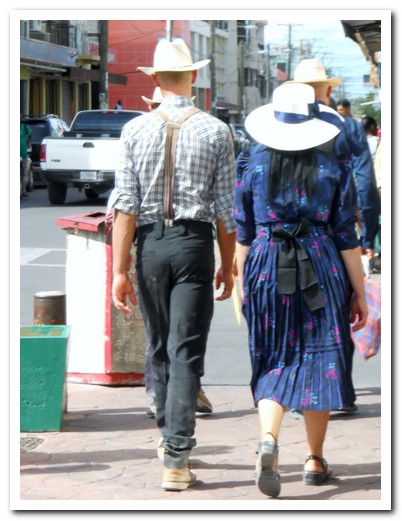
Mennonites come to town
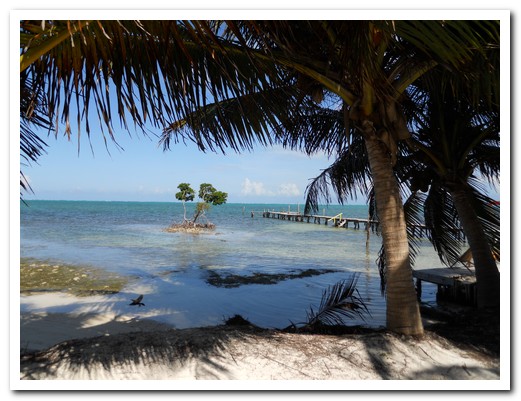
Caye Caulker
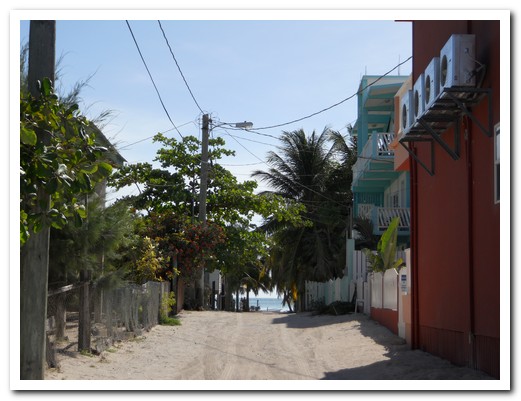
Sandy streets on Caye Caulker

Food cart on the beach

Typical wooden house
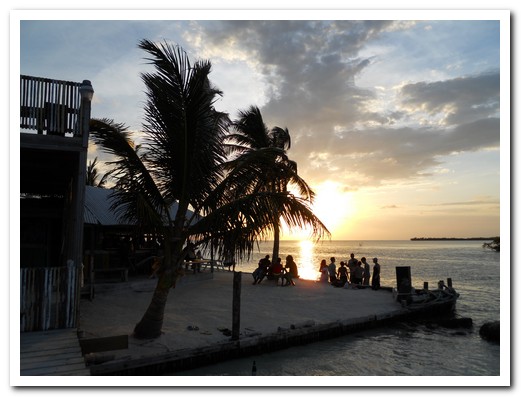
The Lazy Lizard bar at sunset
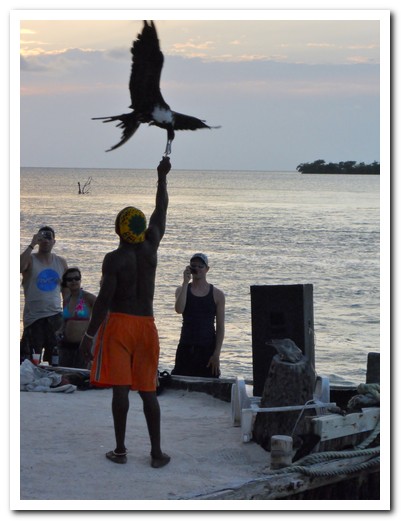
Hand feeding the frigate birds
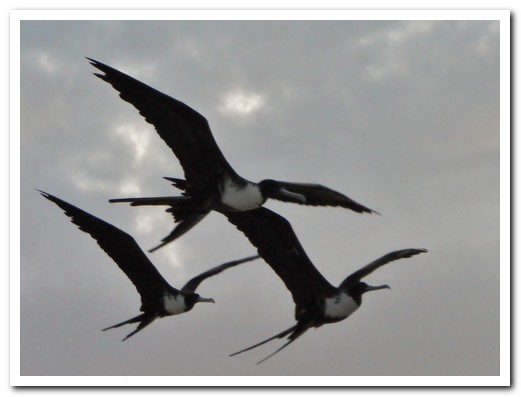
Frigate birds hang around where fish are being cleaned
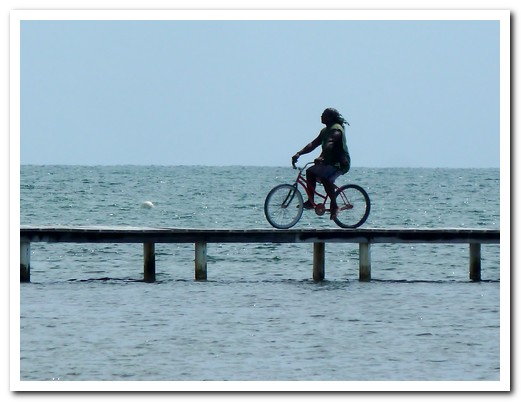
One of the locals riding along the wharf
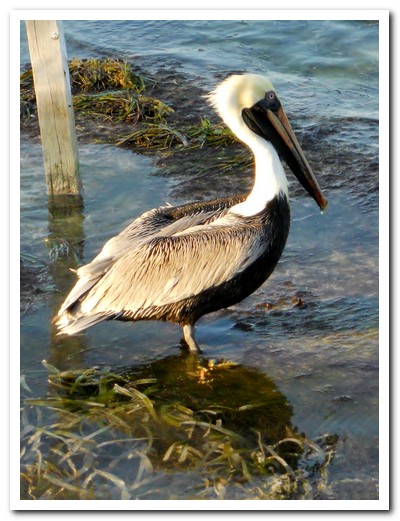
Pelican

Manatee comes up for a breath of air

Manatee feeding on the sea grass
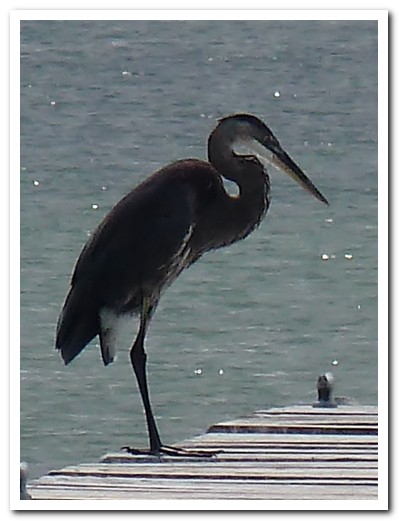
Large heron

Small stingray
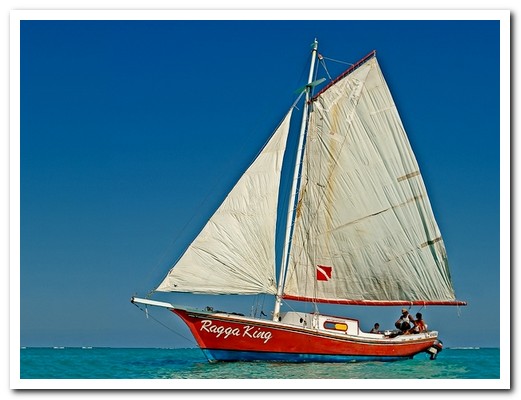
We joined the Ragga King for a 3 day trip along the reef
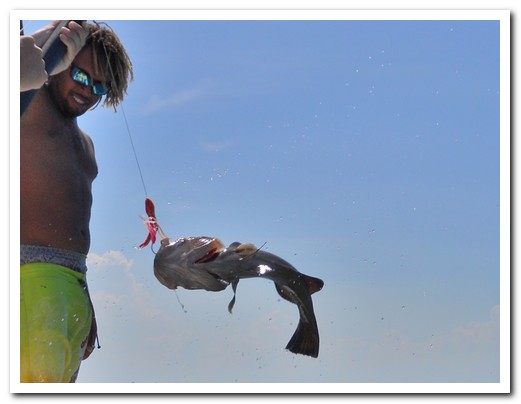
It wasn´t long before the first fish was hauled in
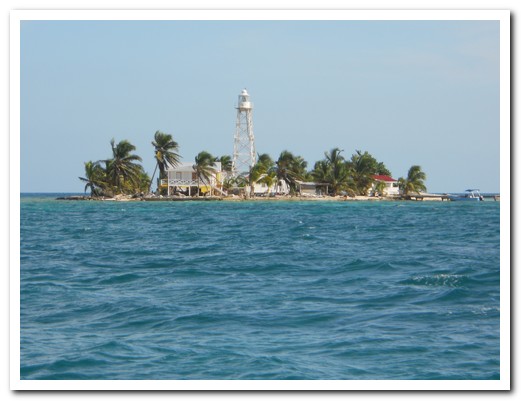
Lighthouse on an isolated island
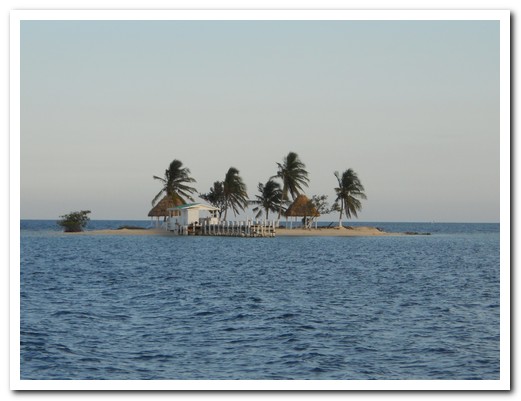
Rendezvous Island, our first night stop
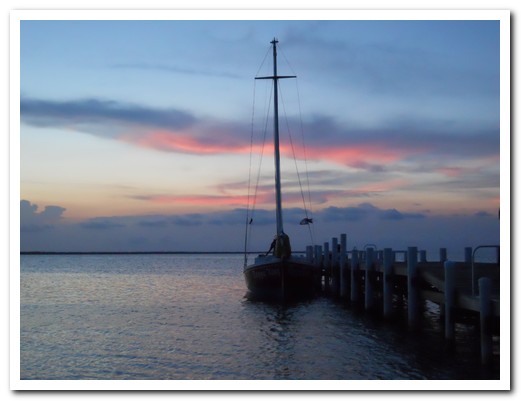
Sunset

Sitting around the campfire with rum punches

Seagull

Captain Patrick speared a bunch of fish for dinner

Tobacco Caye, our second night stop
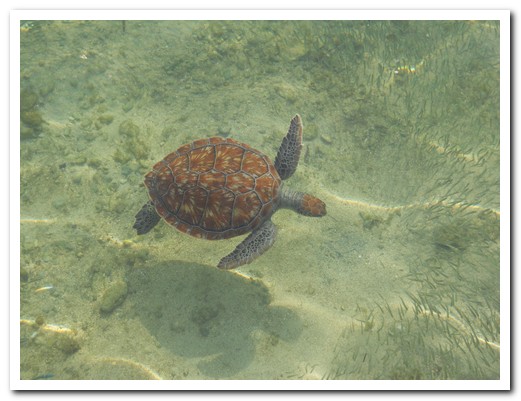
Green sea turtle comes for a feed every afternoon
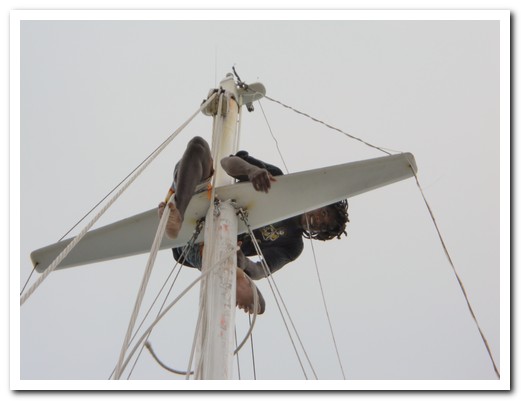
Shane up the mast
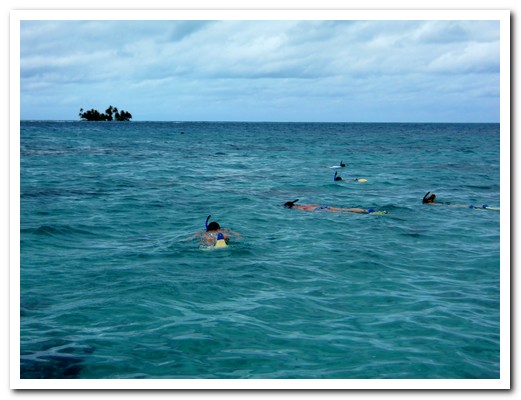
Snorkelling on the reef
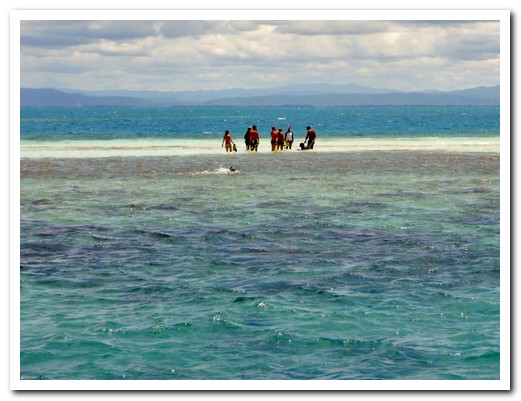
Resting on a sand bar
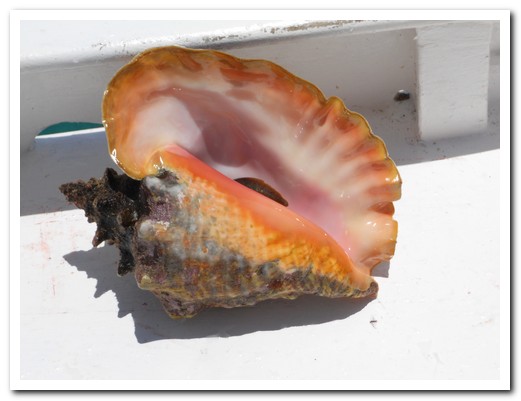
Conc is a popular with the islanders
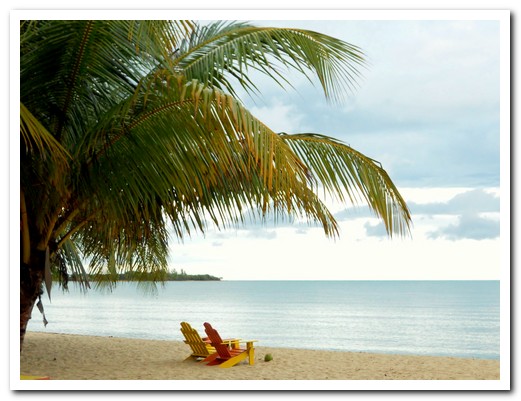
The relaxed Placencia at the end of our trip